WINGED



March is Women’s History Month, a time to reflect on the accomplishments, resilience and contributions of women throughout history. While we celebrate the remarkable strides women have made in various fields, it is also crucial to spotlight those who continue to break barriers in male-dominated industries. In particular, local women working in areas, like medicine, science and leadership roles deserve our recognition and support.
These women face unique challenges, often navigating spaces where their presence can feel overshadowed or undervalued. Their journeys are not always easy: even in the modern era, women in journalism, and other maledominated professions, continue to contend with gender biases, unequal pay, and limited access to leadership roles. It’s important to acknowledge that progress doesn’t happen by accident. It’s the result of deliberate efforts by women who challenge the status quo and push for change.
These women face unique challenges, often navigating spaces where their presence can feel overshadowed”
In the world of technology, where computer programming and engineering have long been seen as male-dominated pursuits, women emerge as leaders. Despite early contributions from women like Ada Lovelace, who is widely considered the first computer programmer, and pioneers like Grace Hopper, who developed the first compiler for a computer programming language, women have often been sidelined or overlooked.
and a lack of representation in leadership positions.
This Women’s History Month, let’s commit to not just celebrating women from history, but uplifting the local women in our communities.
Let’s remember that the work isn’t over, that we must continue to uplift, empower and support women everywhere especially those trailblazing in spaces where their voices are needed most.
Be it in research, business or athletics, women are breaking barriers and proving that there are no limits to what they can accomplish.
EMERGENCY MEDICAL TECHNICIAN TRAINEE NAVYA SAMUEL (12)
FORMER HARKER VARSITY FOOTBALL PLAYER

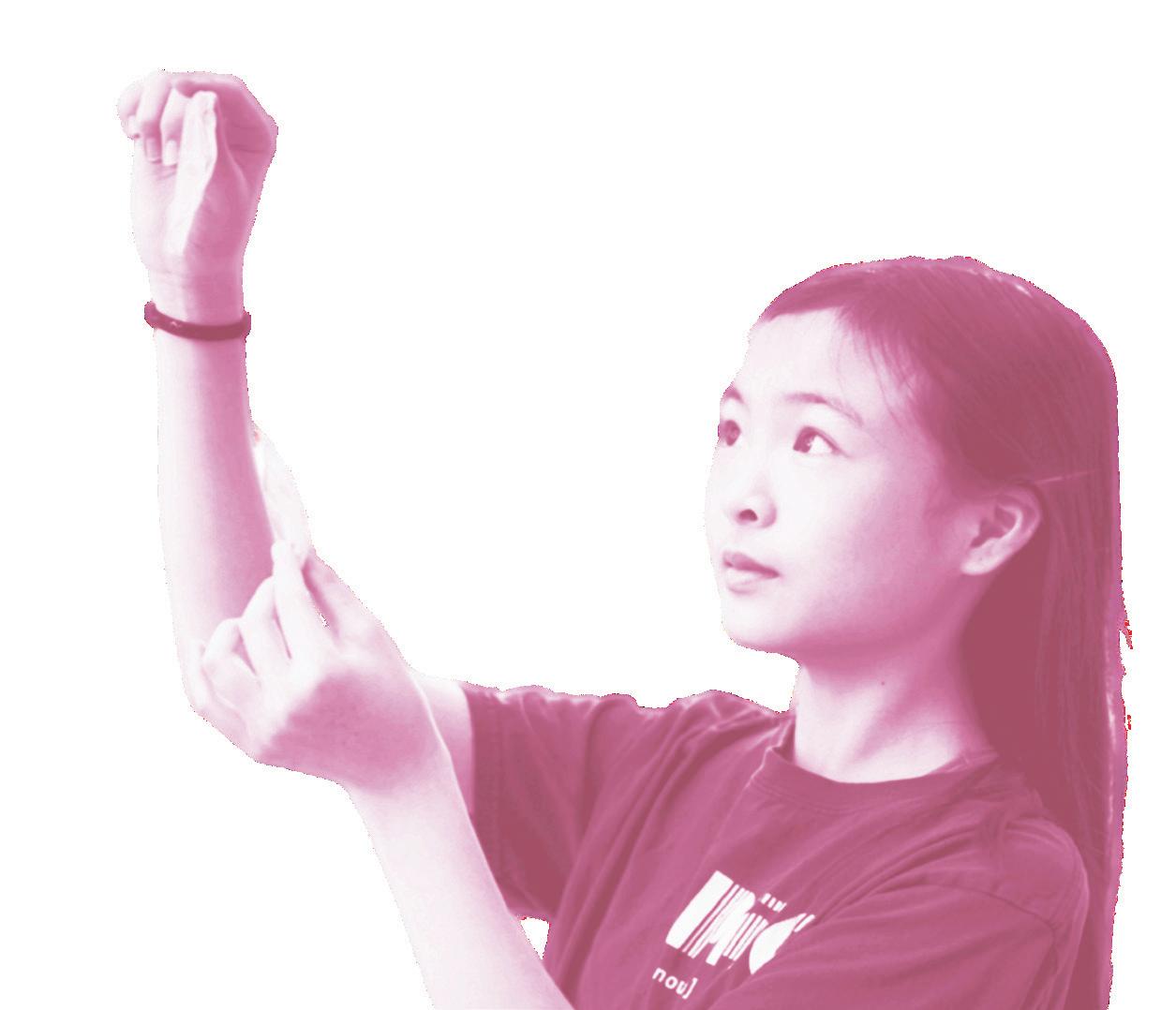
Women in science continue to face challenges such as bias in hiring, unequal pay,
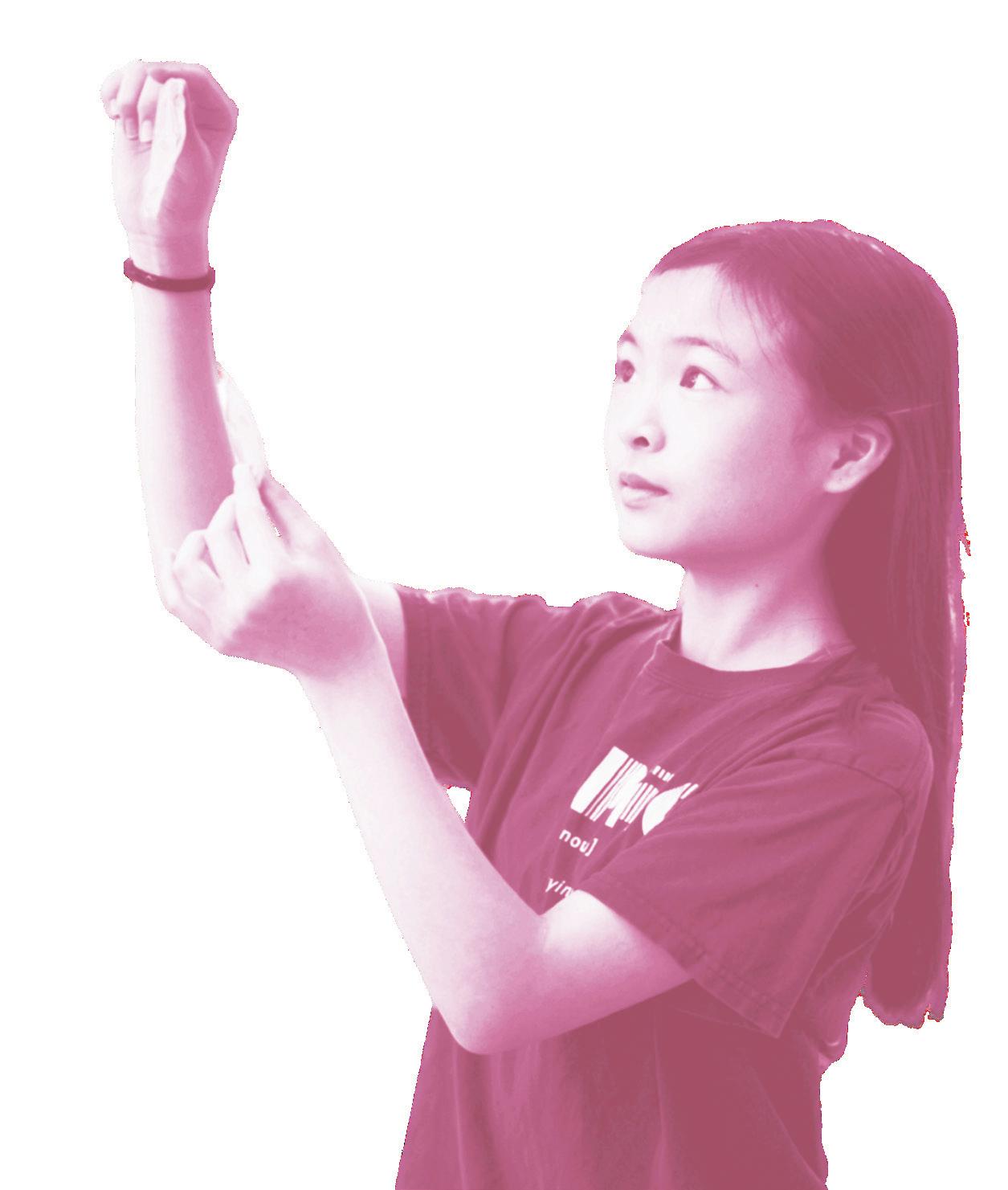
STUDENT RESEARCHER DEVELOPING BIOFABRICS SARIA LUM (9)


DIRECTOR OF TESTING FOR HARKER DECA ABBY ROSE SACHSE (10)



VP OF DECA SILICON VALLEY, VP OF FINANCE FOR CALIFORNIA DECA 2024 EMILY MITNICK (12)


katerina matta
The frosh and senior classes attended Living with Intent, Focus and Enthusiasm (LIFE) sessions focused on substance abuse prevention and college advice on March 14.
Harker alumni spoke to seniors about their experiences in college in a Q&A style. Senior class dean Christopher Hurshman moderated the discussion with Ananya Krishnan (‘18), Katherine Zhu (‘18), Caroline Yager (‘20), Spencer Cha (‘22) and Annmaria Antony (‘23) based on topics students proposed in a Google Form prior to the session.
The conversation with the alumni included discussions on making friends in college, navigating newfound independence in adulthood and battling peer pressure in new social scenes.
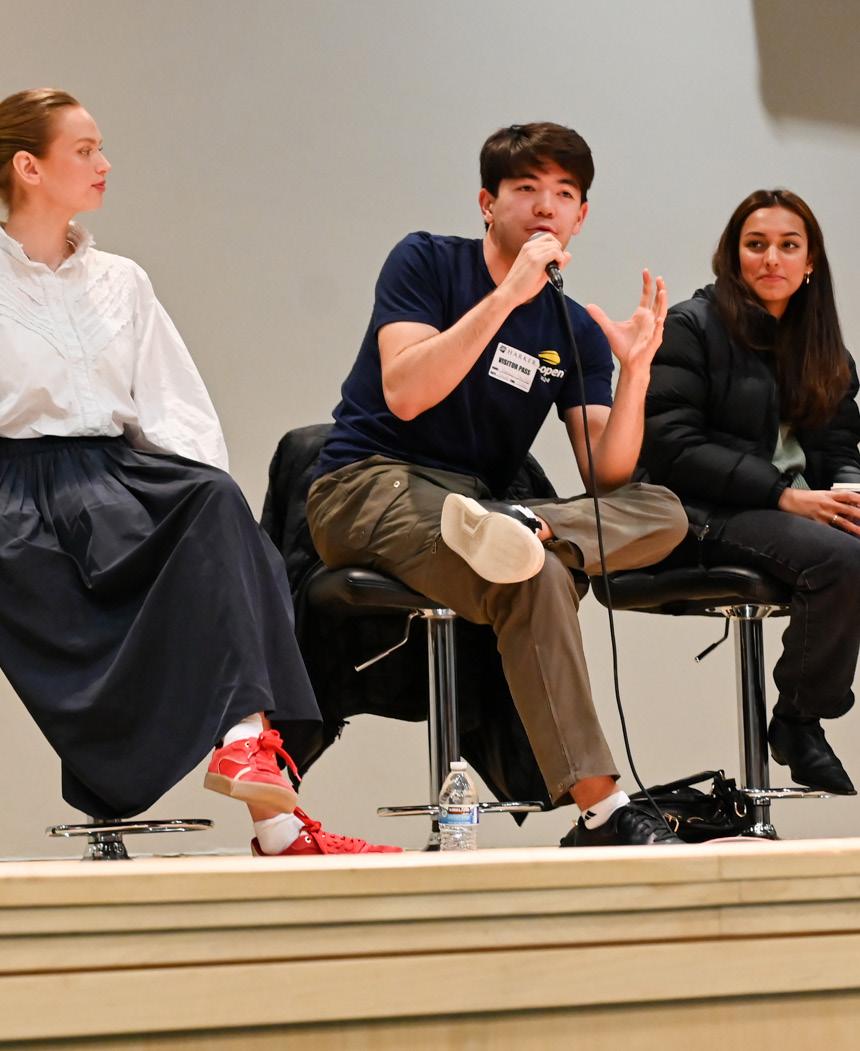
NEW CHAPTER Spencer Cha (‘22) gives advice on how to transition smoothly from high school to college.
Senior Robert Fields appreciated the seniors’ candor as they discussed these challenging topics.
“I actually didn’t expect them to get into [these issues],” Robert said. “They made it seem very candid, and it was a very genuine effort to help people think about situations they might confront. They did a good job of addressing niche concerns that a lot of people had, and it felt very realistic.”
“They did a good job of addressing niche concerns that a lot of people had, and it felt very realistic.”

ROBERT FIELDS SENIOR
Dr. Lesley Kopsick spoke to the frosh as part of her work with Prevention Solutions, a Hazelden Betty Ford Foundation project. Students gained insights into the nuances of substance abuse, from its chemistry to its effects on youth. The session concluded with an interactive roleplay, where students practiced refusing drugs in different social situations.
Frosh Sofe Jalil thought Dr. Kopsick’s approach was approachable and engaging for the audience in raising drug addiction awareness.
“It was a very effective way to show how what drugs you do and how continuing to take drugs doesn’t help you, even though it gives you the mindset that it does,” Sofe said. “Everyone actually got something out of [the session], so I think [Kopsick] definitely made it more accessible towards our grade.”
No LIFE sessions remain for the 2024-25 school year.


Indian Student Association hosted their first Bollywood Night for students, families and faculty on March 15 in the Aux Gym.
Attendees enjoyed a series of Indian cultural performances, emceed by ISA officers Sriteja Kataru (12) and Tanvi Sivakumar (11).
Senior Shivraj Panja played “Chura Liya Hai Tumne Jo Dil Ko” on the electric guitar, while seniors Naiya Daswani and Hasini Namala performed a tabla and veena cover of “Zaalima.” ISA adviser Anu Aiyer sang the Tamil song “Chinna Chinna Asai” while the audience waved phone flashlights to the melody.
Dr. Aiyer explained that she chose that song because the lyrics highlighted finding happiness in small wishes.
“I think it speaks to a lot of people here,” Dr. Aiyer said. “Given that a lot of them are seniors, it’s about wishing them the very best as they go on.”
Parents of seniors energized the crowd with a dynamic routine to “Gallan Godiyan” and “Lungi Dance.” Ritika
Singh, who coordinated the sign-ups and rehearsal times for the parents, highlighted the emotional significance of the performance.
“It was just two or three practices, but everybody chimed in, everybody was excited,” Singh said. “My favorite part was the bonding time to spend the last few weeks together as parents of seniors, and to do something nice for kids.”
“I saw this event really bringing different cultures in India together, full of vibrant energy.”

RUSHIL JAISWAL (12) ISA CO-PRESIDENT
ISA co-presidents and co-founders
Rayan Arya (12), Rishi Lalwani (12) and Rushil Jaiswal (12) closed off the show with a dance to “Make Some Noise for the Desi Boyz.” ISA then opened the
dance floor to all attendees, who gathered in a circle and danced to traditional Bollywood hits.
Junior Savitha Satish ran a henna station, applying mehndi designs on attendees. Attendees dressed in cultural attire like lehengas, kurtas and salwars. They took pictures with family members, friends and teachers against a backdrop of vibrant banners and garlands.
ISA served dinner potluck-style, with attendees contributing their favorite food and snacks from their culture, including dishes like butter chicken, vegetable Pakora, Gulab Jamun and more. Attendees gathered to eat at tables decorated with Punjabi embroidered cloth and traditional Indian oil lamps called diyas.
Rushil explained the inspiration behind the potluck-style dishes.
“We’re really big on community, family, culture,” Rushil said. “Instead of just catering food, everyone brings a piece of them, and then we can understand a piece of each other. I saw this event really bringing different cultures in India together, full of vibrant energy.”
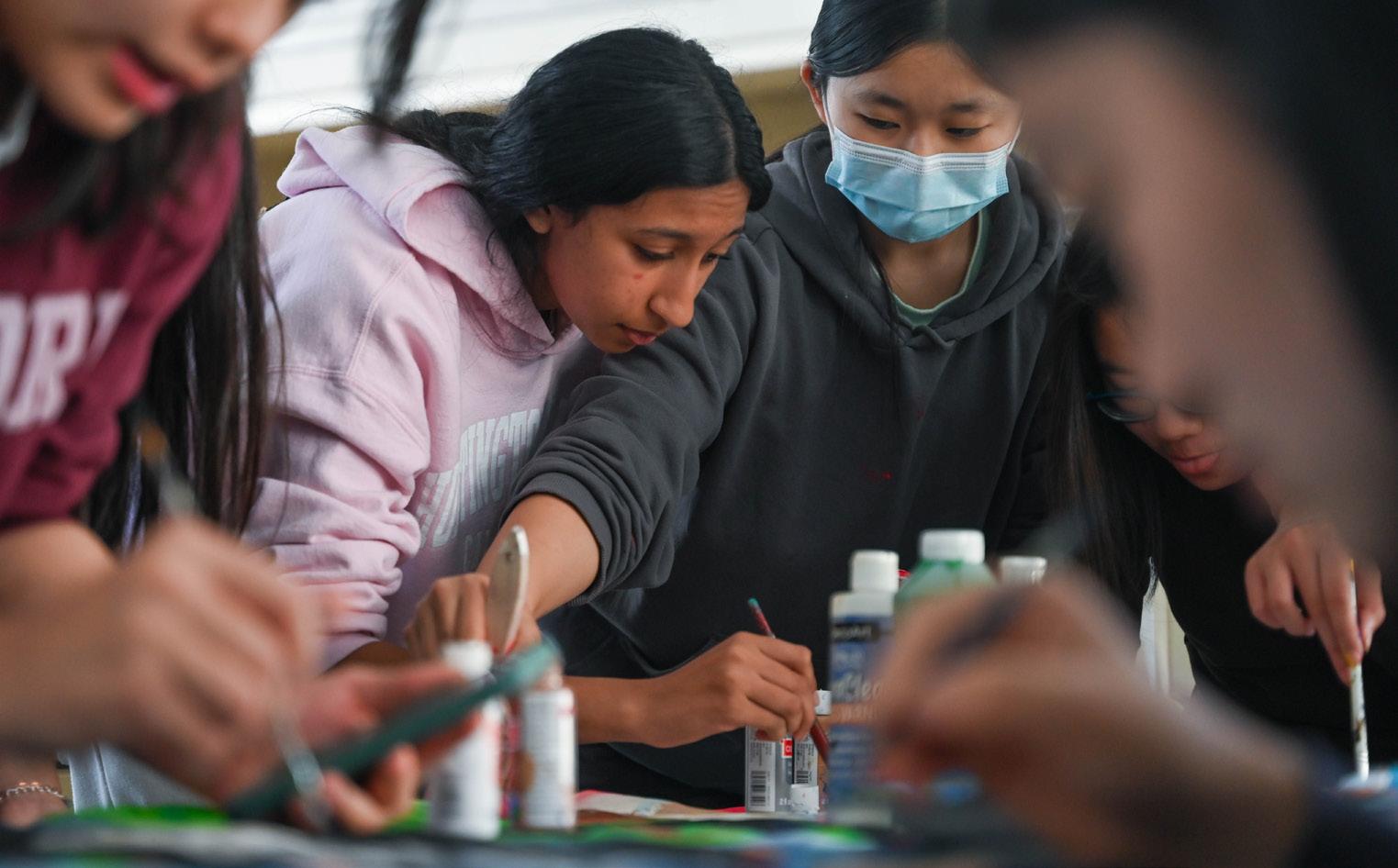
samuel tong, johanna byun, shreyas karnam & aileen jang
Students gathered at Spirit
Each class designed a banner
their respective board game themes.
Seniors decorated a Monopoly banner with different game pieces, juniors transformed their banner into a Clue
board, sophomores painted tropical leaves on their Jumanji banner and frosh depicted a colorful Candyland scene.
Many attendees enjoyed the camaraderie created by spirit preparations. SAB representative Hannah Jiang (10) highlighted the communityoriented nature of Spirit Night.
“For Eagle painting, we have little to no time, and then at the end, everyone works together frantically,” Hannah said. “It’s a bonding time under all this stress.”
Curly fries with a variety of toppings like nacho cheese and bacon bits drew students to Chef’s Grill. The Student Events Committee partnered with the kitchen staff to prepare the snacks, part of an inaugural event called “Fryday.”
“One congregated place where people can get food, talk and paint outside creates a nice bonding experience.”

AMISHI GUPTA (11) STUDENTS EVENTS COMMITTEE HEAD
Students Events Committee Head Amishi Gupta (11) highlighted how food ties together the community.
“It was intentional for us to put Fryday during Spirit Night because we wanted to make sure there was some incentive for people to stay for the long hours,” Amishi said. “One congregated place where people can get food, talk and paint outside on their posters creates a nice bonding experience.”
Female Empowerment Movement Club organized a series of events in celebration of Women’s History Month, aimed at empowering students, sparking dialogue and highlighting women’s experiences.
The club hosted a women’s selfdefense class led by CEO of Wushu Central Martial Arts Academy David Chang to teach students and faculty skills to protect themselves against physical assault on March 12. Chang taught attendees how to respond to common attack scenarios and emphasized the importance of reacting quickly in dangerous situations.
“When an opportunity presents itself, take it. Girls are capable. You’re there for a reason, and you’ll figure it out.”

ANU AIYER
MATH TEACHER
“The scary thing is that it’s actually very likely to happen,” Chang said. “Statistically, one in every three women in the United States will be physically assaulted sometime in their life. In college, one out of every four women will be sexually assaulted, so you have to know what to do if and when that happens.”
While these possibilities may seem unlikely, FEM Club Adviser Donna Gilbert explained the very real fears that inspired the event.
“It came out of a conversation we had about things that you worry about in life as a female,” Gilbert said. “We talked about how we carry pepper spray even when we go walking around our neighborhood and wondered how many other people do it too.”
FEM Club hosted a Q&A with female teachers who worked in maledominated fields in collaboration with Women in STEM Club on March 18.

History teacher Carol Green shared anecdotes from her experience as a political science major, while computer science teacher Swati Mittal highlighted the different hierarchical dynamics and treatment of women in the American work environment compared with India.
Math teacher Anu Aiyer encouraged female students to take chances in both college and work despite uncertainties about self-worth.
“When an opportunity presents itself, take it,” Dr. Aiyer said. “I feel like girls and women think, ‘Should I do it? Will I do a good job? What if I don’t do a good job?’ By that time, some guy who is probably more clueless does the job. Girls are capable. You’re there for a reason, and you’ll figure it out.”
Dr. Mala Raghavan reflected on her mother’s and grandmother’s stories in pursuing education.
“[My mother’s] seat was given away even though she had better scores, so my mother was always obsessed with me getting an education, and that was part of the reason why I ended up doing PhD and post-doc,” Dr. Raghavan said.
“I realized now that to have some kind of economic independence is huge for women. I got an education in chemistry, so it was convenient for me to get a job and to do anything.”
FEM Club officer Isabelle Niu (10) moderated the discussion and asked questions about teachers’ career journeys. Students attended a discussion on transgender women in sports on March 20, covering topics from the language used to government intervention.
“[People] shouldn’t be scared of choosing topics that are more ‘out there’ because you can have actual varied discussions about them.”

SOPHIE PELLET (11) ATTENDEE
Attendee Sophie Pellet (11) acknowledged the importance of discussing controversial topics.
“I went because I thought that it would be interesting, and I could make my voice be heard,” Sophie said. “[People] shouldn’t be scared of choosing topics like these that are more ‘out there’ because you can have actual varied discussions about them.” Visit harkeraquila.com for more.
Juniors reunited with their fourth grade Eagle Buddies at the Bucknall campus while sophomores met with the third graders in the Athletic Center for Pi Day activities during their last Eagle Buddies event of the year on March 14.
At Bucknall, Eagle Buddies tossed beanbags, weaved lanyards and colored pictures indoors. Lower school Bucknall Enrichment Staff Team member Zeke Gallegon supervised the lunchtime activities and appreciated how the juniors acted as role models.
“
Eagle Buddies gives fourth graders a chance to talk to high schoolers, and it’s fun for us because we can feel like fourth graders again.”
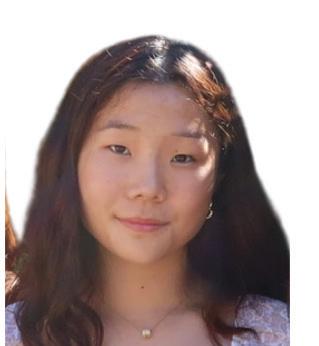
“The
BRENNA REN (11)
EAGLE BUDDY
and had similar

Medical Club hosts diagnosis simulation
Medical Club hosted its annual Diagnosis Event, inviting students to step into the role of doctors by diagnosing diseases simulated by club officers on March 18.
“This diagnosis event is incredibly beneficial because it’s not just reading symptoms out of a textbook,” Medical Club adviser Matthew Harley said. “It teaches students how to work with patients who might not be very forthcoming with all their symptoms, requiring them to ask the right questions and probe deeper.”
The two main case studies featured diabetes and arthritis, but officers also included misleading symptoms that mimicked other chronic illnesses, making the diagnostic process more complex.
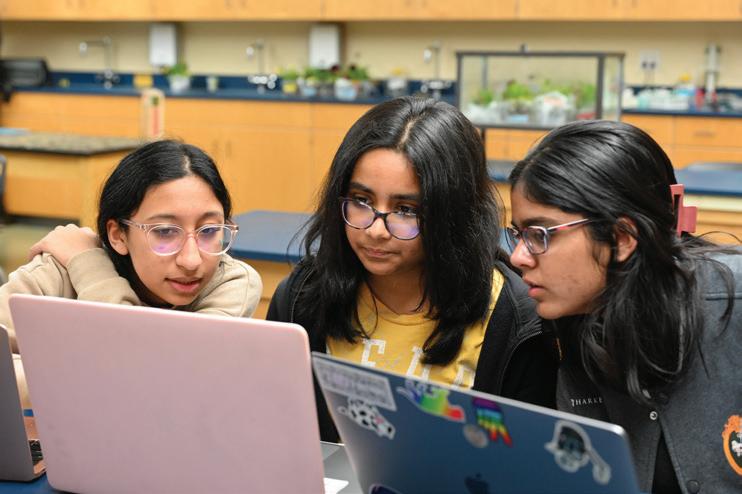
DISEASE DETECTIVES Med Club members practice differential diagnostic procedures at the club’s Diagnosis Event.
“The Diagnosis Event is my favorite out of all our events it’s the one event where officers actually get to engage with club members,” Medical Club officer Mindy Truong (11) said. “I wrote one of the case studies about rheumatoid arthritis and this 22-year-old pastry chef. It’s great because you’re stepping into the role of a doctor by diagnosing your patients, and there’s no real consequence if you make a wrong diagnosis.”

experiences,” Zeke said. “They get to see the opportunities of success that they have in the future. Everyone is having fun, and it’s like a big party.”
Juniors also played basketball, soccer and playground games like Wall Ball with their Buddies. Brenna Ren (11) commented on how the event allowed her to reminisce on her own time at the lower school.
“It’s always super fun seeing how much [my Eagle Buddy] improved at
basketball,” Brenna said. “I like talking to my Eagle Buddies and learning about their lives. Eagle Buddies gives fourth graders a chance to talk to high schoolers whom they usually don’t have a chance to talk to, and it’s fun for us because we can feel like fourth graders again.”
Sophomores hosted their Eagle Buddies on the upper school campus for the first time, participating in Pi Daythemed activities.
Visit harkeraquila.com for more.
“ It teaches students how to work with patients who might not be forthcoming with all their symptoms, requiring them to ask the right questions and probe deeper.”

MATTHEW HARLEY MED CLUB ADVISER
The event, which has been a part of the club for four years, was inspired by a former student who participated in a similar program at Stanford University and found the approach helpful. Medical Club officer Lucas Chen (11) expands on the usefulness of this diagnostic event for future doctors in the Harker community.
“If someone is interested in becoming a doctor in the future, this activity is a great step toward that because it provides hands-on experience,” Lucas said. “In the real world, doctors rely on lab tests and symptoms to determine a diagnosis, and we were able to replicate that process for members to practice and gain experience.”
Med Club officers plan to continue the interactive format in the future, with events like a dissection activity.

chelsea xie
US strikes Yemen, targets Houthi rebels
The US attacked Yemen cities Sanaa and Sadaa with at least 10 airstrikes to target potential headquarters of the Houthi rebels on March 18. The Houthis are an Iranian-backed rebel group who have attacked over 100 Israeli merchant ships to pressure Israel to end its war on Gaza since Nov. 2023. The Trump administration aims to deter Houthi attacks and continue pressuring Iran.
Russia and Ukraine exchange prisoners
Russia and Ukraine swapped 175 prisoners and captured civilians at their northern border on March 19, one of the largest exchanges of war prisoners since the war started over three years ago. Families reunited with the released Ukranian prisoners in Cherniv. The swap comes amidst negotiations among Ukraine, Russia and the US over a limited ceasefire involving the protection of energy infrastructure in both countries.
Mexico City bans violent bullfighting
Mexico City officials banned violent bullfighting in a historic 6-1-1 vote, outlawing the use of sharp objects and the killing of bulls after matches on March 18. The ruling, which allows nonviolent bullfighting to continue instead of banning the tradition entirely, aims to balance the concerns of matadors and cultural advocates with those of animal rights activists. Officials had previously banned bullfighting in 2022, but the Mexican Supreme Court overturned the controversial policy after local economies suffered from a decline in tourism following the ban.
M23 withdraws from peace talks with Congo
The M23 rebel group withdrew from scheduled peace talks with the Congolese government on March 17. Due to international sanctions on core M23 members like leader Bertrand Bisimwa, the group refrained from attending the peace talks in Luanda, hosted by the Angolan government to mediate the conflict between Congo and the rebel group. Tensions between Congo and Rwanda increased after Rwanda severed diplomatic ties with Belgium in response to Belgium sanctioning several M23 rebels and a Rwandan mining company.
China sends military ships, planes, drones around Taiwan
China deployed 58 military ships, planes and drones into the water and airspace surrounding Taiwan on March 18, an unusually large show of force compared to its regular efforts to pressure the Taiwanese military. Despite Taiwan’s rejection of China’s sovereignty claims, the country remains the target of continuous military drills. Tensions between Taiwan and China continue to escalate, especially after the United Nations cited China as a risk to maritime security on March 13.

Bay Area shoppers continued watching prices closely as the latest round of tariffs from the Trump administration created uncertainty about the cost of essential products. While Trump suspended many of the threatened tariffs, their possible return in April causes worry among businesses and consumers.
“A lot of what was done with Canada and Mexico was to project strength and an ‘America First’ mindset.”

SAMUEL LEPLER
“It’s frustrating because everything is already expensive, and now they’re talking about making it worse,” Lion Market shopper Jessica Lam said. “They need to stop playing politics with regular peoples’ food prices. I’ll just be paying
more for the same things”
Trump announced tariffs on Canada, Mexico and China, the U.S.’s three largest trading partners, starting in January. He imposed tariffs of up to 25% on these countries on February 1, but paused those on Canada and Mexico for 30 days. The tariffs resumed on March 4, only to be mostly suspended again two days later. They are set to return on April 2.
Economics teacher Sam Lepler views the tariffs politically motivated and believes they will have lasting economic effects.
“With regard to Canada and Mexico, Trump ran on issues like illegal immigration, drug trafficking, especially fentanyl, and an ‘America First’ agenda that focused on protecting American jobs, American businesses,” Lepler said. “A lot of what was done with Canada and Mexico specifically was a threat to get more assistance on those issues, and also to project strength and an America First mindset.”
Fresh produce is one of the most vulnerable categories targeted by tariffs.
The US imported around 60% of fruits and 40% of vegetables in 2023, including 91.9% of its avocados and 91.4% of its raspberries, with Mexico supplying the vast majority. These items, along with other groceries like tomatoes, cucumbers and limes, could see prices increasing within weeks if tariffs return.
Liquor prices could also increase, with Trump threatening a 200% tariff on European alcoholic products in response to the European Union’s plan to impose a 50% tariff on US whiskey.
“We’ve been watching the prices on French wine specifically and other European alcohol,” Safeway employee Paula Whitaker, who works in the liquor department, said. “The concern is what will happen in the coming weeks if the tariffs come back for good. If costs start rising, stores will probably have to adjust their prices pretty quickly. ”
For many shoppers, the gradual rise in prices has led to changes in purchasing habits. According to global market intelligence agency Mintel, 54% of adults are making compromises in their food and beverage choices in response to inflation.
Lam worries that the tariffs will only make the situation worse.
“I’m shopping at multiple places because prices are just getting out of hand in some places,” Lam said. “If prices keep going up, I’ll have to figure out how to cut back even more.”

Dozens gathered outside a Tesla showroom in Palo Alto to denounce sweeping federal cuts proposed by billionaire Elon Musk and his Department of Government Efficiency on Mar. 22.
Demonstrators voiced outrage over cuts to key social programs like Social Security, Medicare, and the Department of Education. They held signs reading “Defund Musk” and “Honk if you hate Elon Musk,” prompting a steady stream of car honks from El Camino Real.
“This is the only way to get his attention,” protester David said. “We need EVs, but we also need Musk out of our government. He’s not elected. He has zero compassion. And now he’s trying to take away our future.”
The demonstration was part of the national Tesla Takedown movement, which aims to target Elon Musk’s most profitable company by encouraging people to dump Tesla stock, boycott the brand and protest outside showrooms.
Protest attendee Andrea emphasized a need for people of all political and social orientations to come together under a common goal. However, she also clarified that her issue was with Elon Musk, not people who drive Teslas.
“For this protest, we’re boycotting Tesla, not the drivers, but the company,” Andrea said. “Elon is the main tool right now, swinging a chainsaw, cutting and breaking the government. They’ve got

the military, the army, the FBI. But what we have, our only power, is the people.”
The Tesla Takedown protests have occurred in Palo Alto every Wednesday and Friday for the past seven weeks, with similar demonstrations at Tesla showrooms across Silicon Valley, including one at Santana Row on Mar. 21.
Several participants took a more active role, walking through the crowd with speakerphones to amplify their message. Among the groups present were the Raging Grannies, a national collective of older women, who led chants opposing cuts to Social Security.
“We make a fuss,” said Raging Grannies member Granny Rose. “We sing, we show up and today, we’re here because our Social Security is under threat. It’s something we all paid for, and it helps so many people: disabled children, veterans, retired spouses.”
Despite the energy and turnout, several protesters voiced their frustration at the lack of younger people present.
“Where are the young people?” David said. “This is your future. You’re going to live longer than us. You should be out here.”
Visit harkeraquila.com for more.
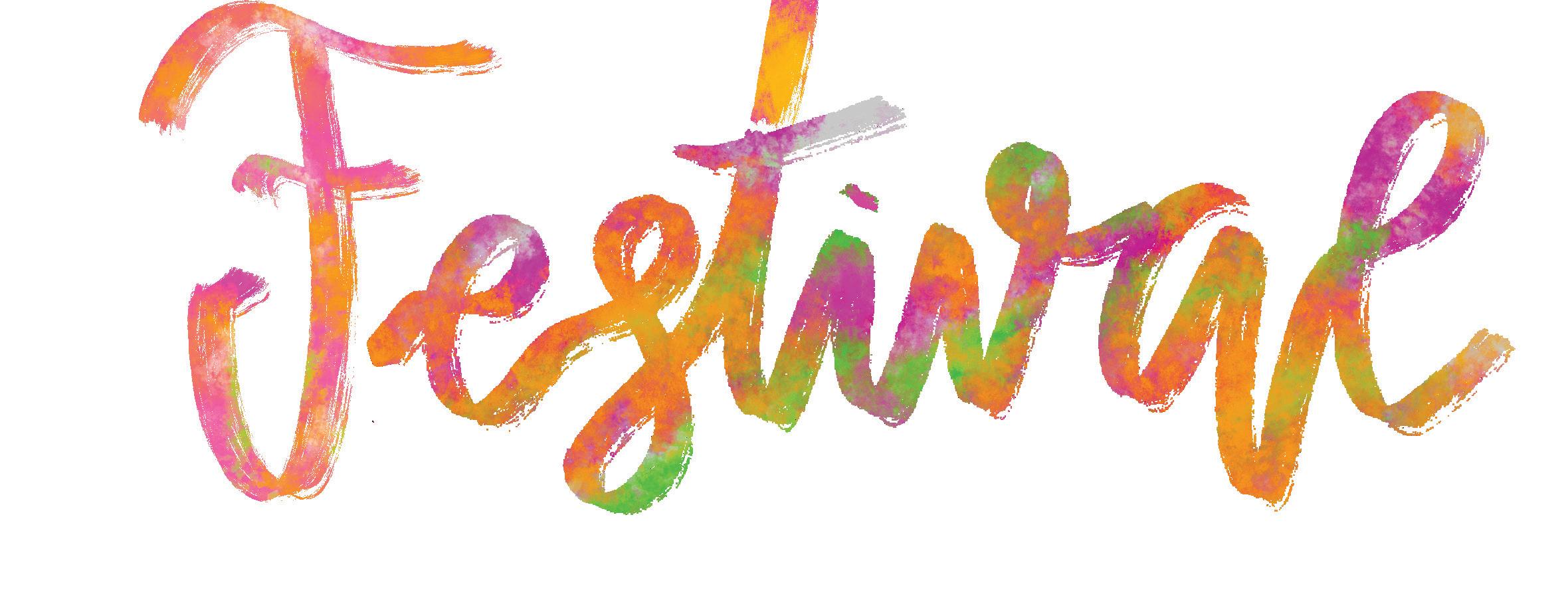
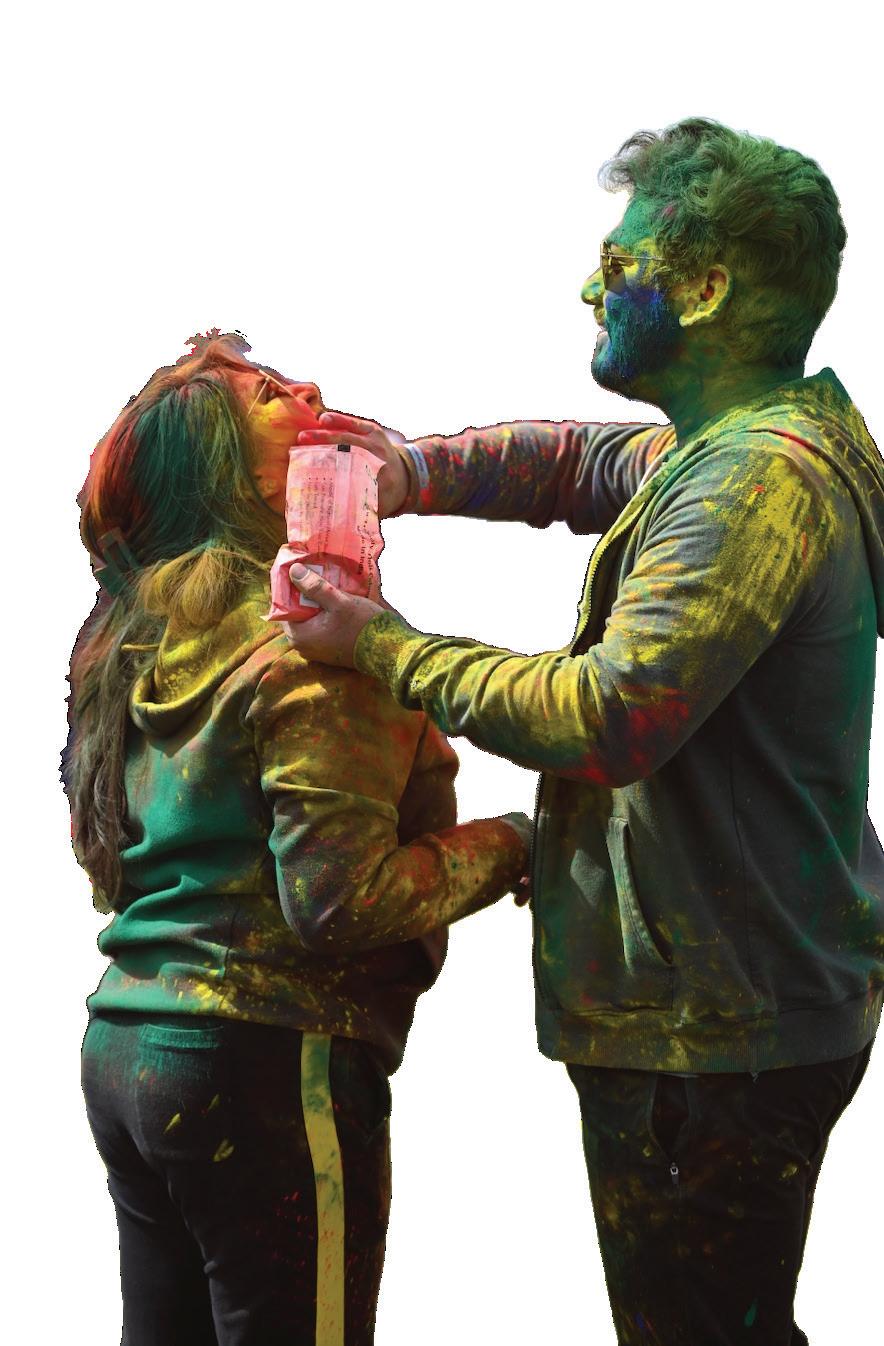

Flashes of striking colored pigment disperse in the sky. Upbeat desi music reverberates through the crowd. People of all ages throw colored powder and water at each other as laughter and cheers of joy fill the air. This is Holi.
This year, Holi was celebrated from March 12 to 13. Known as the “Festival of Colors,” the Hindu festival of Holi celebrates the beginning of spring and the victory of good over evil. It is celebrated on the last full moon day of the month Phalguna from the Hindu lunar calendar.

symbolizes nostalgia for me because it reminds me of when I was a child, and I used to look forward to Holi for weeks. We used to buy water guns and colors before the Holi event, and it was really fun because we’d debate which water guns to get, so pre-Holi shopping brought me closer to my friends.”

Events in the Bay Area hosted hundreds of people participating in Holi activities, from throwing colored pigments to dancing to upbeat music. These events welcome people of any age or background and create an environment full of excitement and

Although the throwing of gulal may appear purely festive, the colors hold deeper symbolism. Red represents love and fertility, while green signifies spring and new beginnings. According to Hindu tradition, blue reflects the color of Lord Krishna’s skin, whereas yellow
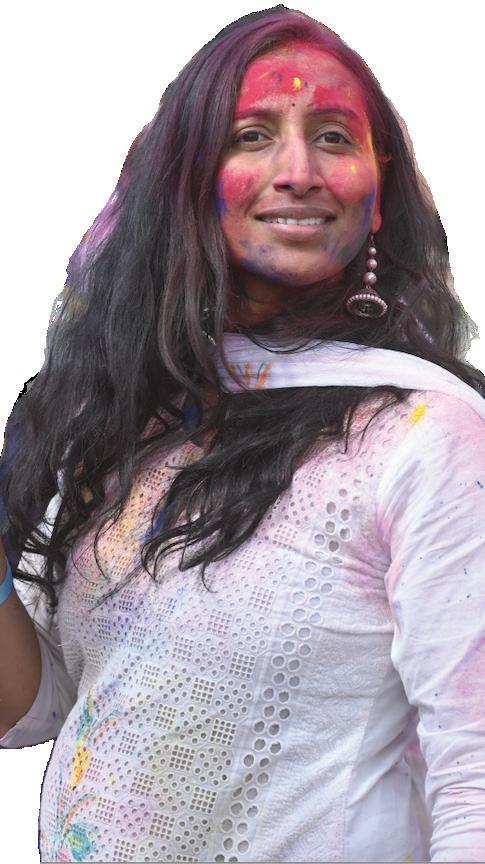
The holiday symbolizes nostalgia for me because it reminds me of the days when I was a child.”
(12)
For many individuals, Holi is not only a celebration of color but also a way to connect with their culture and loved ones. Each family celebrates Holi with unique traditions. For Aarav Borthakur
In addition to connecting community members, Holi commemorates the legend of Prahlad and Holika, two central figures in Hindu mythology. According to scripture, Prahlad, a devout follower of Lord Vishnu, survived an attempt on his life by his aunt Holika, who tried to trick him into sitting on her lap in a fire. Protected by Lord Vishnu, Prahlad emerged unharmed, while Holika was consumed by the flames. To commemorate Prahlad’s victory and ward off evil spirits, Hindus celebrate Holika Dahan on the night before Holi by lighting bonfires
“My family always goes into the festival with white shirts, and we all come out drenched in color.”

INDIAN STUDENT ASSOCIATION SECRETARY
to burn evil presences.
Indian Student Association Secretary Tanvi Sivakumar (11) remembers learning about the religious background of Holi and recalls the legend behind the celebration each year.
“Holi has always been super fun because my family has always gone to huge celebrations with many of our family members,” Tanvi said. “My family always goes into the festival with white shirts, and we all come out drenched in color. When I

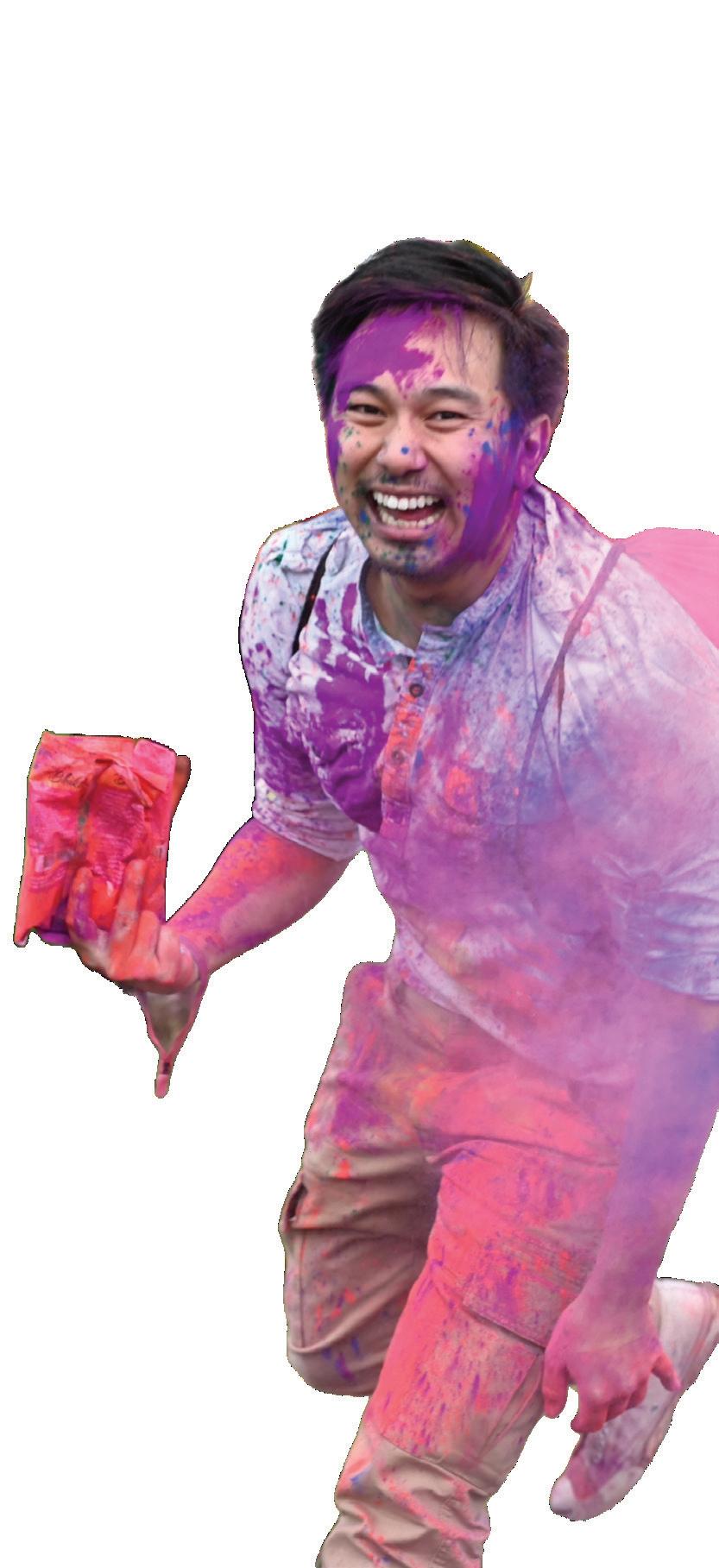






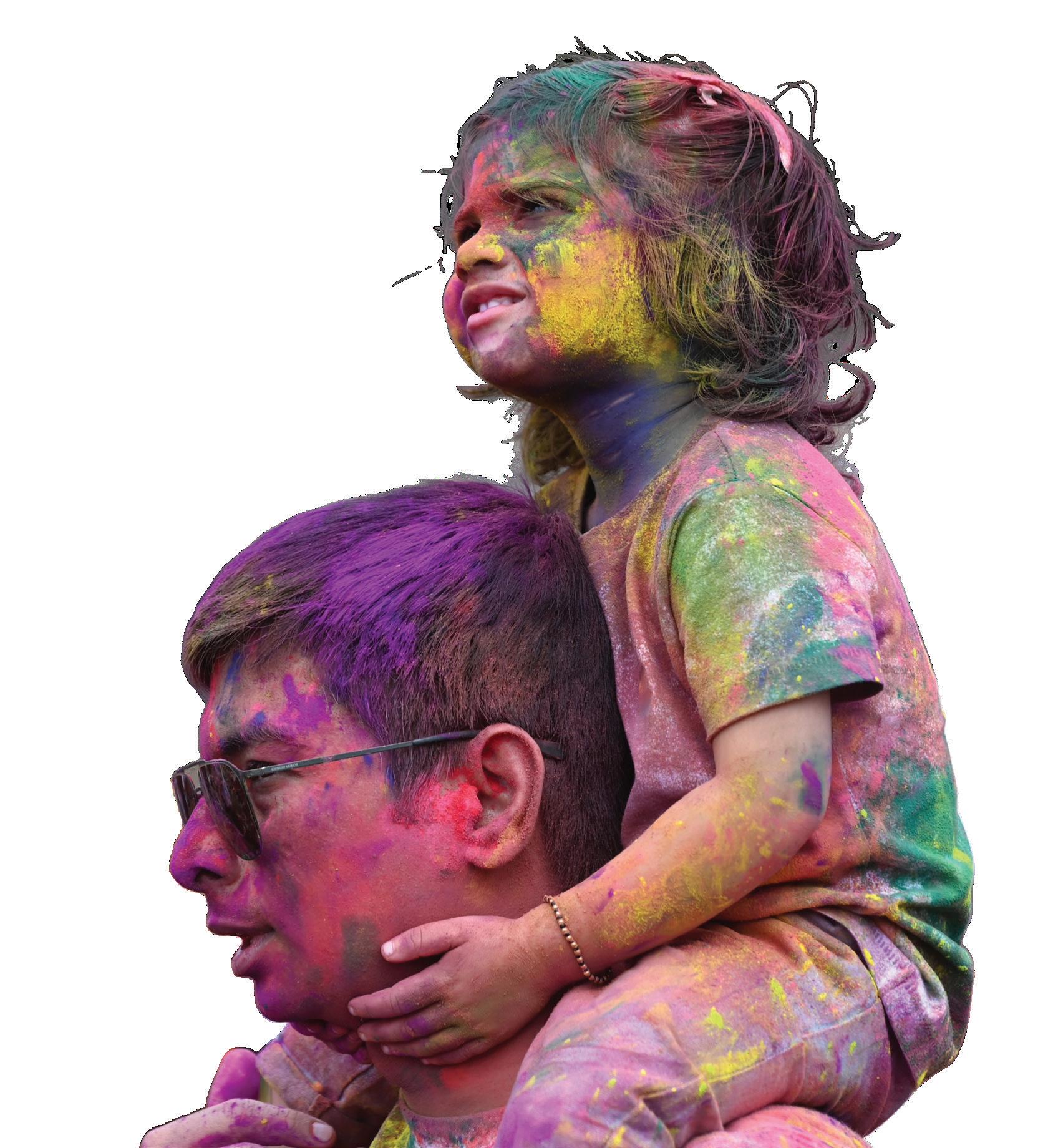

When chemistry teacher Mala Raghavan sprinkles powdered cumin seeds into hot oil, she’s applying scientific principles that extend far beyond the kitchen. The crushed seeds create surfaces from which gas bubbles can escape, preventing the violent eruption called “bumping,” the same concept her AP Chemistry students observe when using marble chips in their lab experiments.
“When you do organic synthesis, you need to add marble chips because it gives a venue for the gas bubbles to disperse in a uniform way,” Dr. Raghavan said. “Otherwise you create superheating of the liquids, and when that happens, the bubbles accumulate, the pressure increases and the liquid will spurt out. My grandmother knew this principle without the scientific explanation — it’s something grandmothers have learned through experience.”
Dr. Raghavan’s cooking journey began after moving to the United States from India at age 30, where she had completed all her education including graduate school. In India, she had never needed to cook, as university housing provided dining halls without kitchen facilities. Faced with an unfamiliar environment and longing for the comforting flavors of home, she began teaching herself to cook.
“When I came here in the 1990s, there were not that many varieties of packaged food available, especially South Indian dishes,” Dr. Raghavan said. “I had to ask my mom to give me recipes, because I really wanted to eat these foods. But slowly, I realized with my own chemistry expertise that it clearly made sense to me, and if I needed to modify anything, I would actually improvise too.”
Cooking quickly evolved from a necessity into a lifelong passion. Dr. Raghavan applies her scientific knowledge to understand the chemistry behind cooking techniques: why bicarbonate makes baked goods light and fluffy by introducing carbon dioxide, why specific temperatures are needed
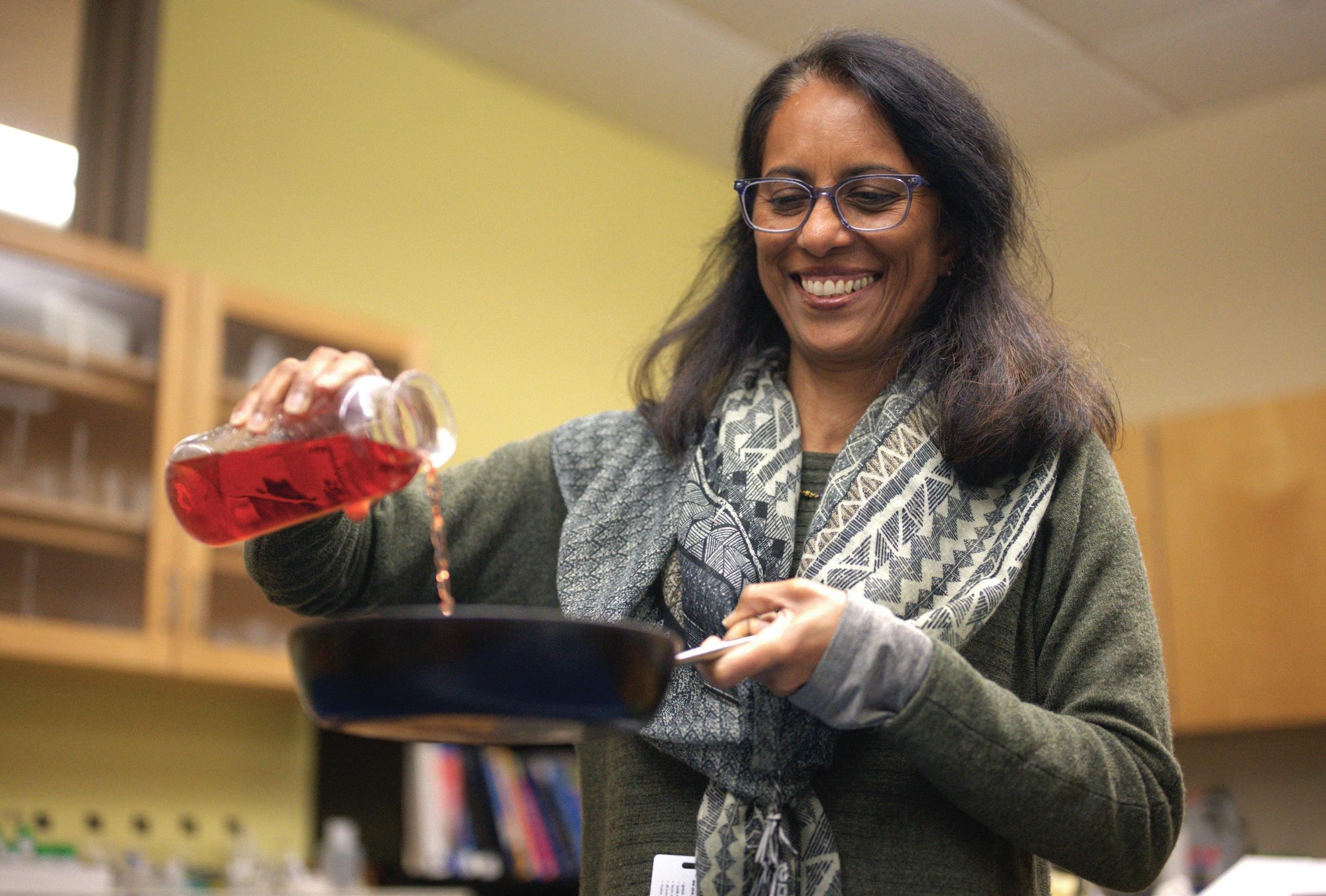
for fermentation of yogurt or why deep frying requires moisture control to
“
I love doing demos, experiments and blowing things up. Getting the kids involved is the fun part.”

MALA RAGHAVAN CHEMISTRY TEACHER
prevent splattering.
“When my mom and grandmother used to cook, they all eyeballed the quantities,” Dr. Raghavan said. “They never had a full measurement. But due to
my chemistry training, I make everything in measurements. There’s just a lot of chemistry in everything.”
Dr. Raghavan’s ability to innovate extends to adapting traditional recipes with locally available ingredients. When unable to obtain raw mangoes for a favorite South Indian mango rice dish, she substituted them with cut apricots to modify the recipe, using an Indian technique with ingredients available in the U.S.
“One of the most fundamental concepts in chemistry is reaction stoichiometry. It’s the same idea that cooks have been using for centuries in their recipes,” Dr. Raghavan said. “While chemistry relies on moles to measure the amounts of reactants, cooking uses a variety of units to describe ingredient quantities. Students often bring in
complicated formulas to determine limiting reagents, but the limiting reactant is simply the ingredient that runs out first and limits how much product you can make — just like in a recipe.”
One of her favorite demonstrations involves heating paraffin wax and dipping it into ice water, which causes a big explosion. This experiment reliably surprises students, allowing them to enrich their knowledge about thermochemistry and creating engaging and memorable learning moments.
“When we tell you that freezing water releases heat, there’s nothing better than doing chemistry to show you that,” Dr. Raghavan said. “I love doing demos and experiments and blowing things up. Because it’s experimental science, instead of lecturing all the time, getting kids involved is the fun part.”
Many advisories develop their own

Michael Acheatel’s advisory developed their own version of basketball: “chair ball,” played exclusively from the chairs. Acheatel’s room is equipped with mini hoops and rolling chairs, allowing students to glide across the room while executing the maneuvers and teamwork skills of regular basketball.
“In the first couple of advisories, we were just shooting around, and once, we said ‘Do you guys want to play’ while we happened to be on our chairs,” frosh Ossi Carrico said. “It brings us together, and it’s a really fun and unique way to bond.”
The advisees also set up a “player competition” chart on the whiteboard, where they compare themselves to established NBA players based on the way they play in each game. They play almost every advisory period.
History teacher Karen Haley began her tradition of a cereal bar for advisories before she even joined Harker. At the start of each year, advisees collectively bring in their favorite cereal boxes to share with cold milk and conversation. Some popular flavors include Captain Crunch, Lucky Charms and Cinnamon Toast Crunch.
“Students are rushing out the door and don’t have breakfast,” Haley said.

“Then they come in and are hungry, so I started the cereal bar with my advisory. They would start coming in even when it was not an advisory day, and it just made everyone happy.”
The Oliver advisory built a lighthearted tradition centered around the charades game “Heads Up.” Acting out animals to expressions, advisees enjoy the challenge of guessing different
answers while watching their friends perform dramatic and ridiculous gestures. “Heads Up” has been a staple of the Oliver advisory, creating an exciting break from the school day.
“We all end up laughing at our poor imitation of the animals,” junior Ethan Lei said. “Mr. Oliver always makes these funny moves which helps us to guess the correct animal.”

Pop culture isn’t just entertainment — it’s a measure of belonging. From inside jokes in classic sitcoms to charttopping songs, American media signals who “fits in.” For immigrant youth, this raises a crucial question: how do you blend your heritage with the culture around you?
Junior Aanya Shah, the child of two Indian immigrants, feels this tension deeply. Aanya has come to navigate her feelings through art, finding a space where she can merge both her Indian roots and the American culture she experiences daily.
“I feel like I’m stuck between two worlds,” Aanya said. “At school, I don’t always relate to the things my peers talk about, and at home, I feel like I’m not fully connected to my family’s traditions. Art helps me create a space that is entirely my own.”
singluar identity.
“I do feel like there’s an expectation to fit into certain boxes,” Aanya said. “It’s like you either have to completely embrace your heritage, or you have to be fully American. But I don’t think it has to be one or the other.”
Like Aanya, Vera Sorotokin, a sophomore whose Russian father and Ukrainian mother have shaped her upbringing, also grapples with her dual identity. Growing up with these two cultural influences, Vera’s art became her tool for reconciliation.
“Through my work, I really hope to connect both sides of my family,” Vera said. “That’s been a long, long wish of mine because we’ve had so much conflict between the two sides in my family, too. So another goal for my paintings is to bring everyone together and eventually reach peace. I don’t know if that’s possible, but that’s my hope.”
Vera’s artwork embodies
bridging cultural divides that run deep in her family, reflecting a broader struggle that many children of immigrants face.
Senior Iris Cai’s exploration of identity takes a different form — through poetry. Iris, who hails from a Chinese family, uses her writing to capture the complexities of her Asian American experience.
“
with my family members about tradition versus following my own path influence my writing.”

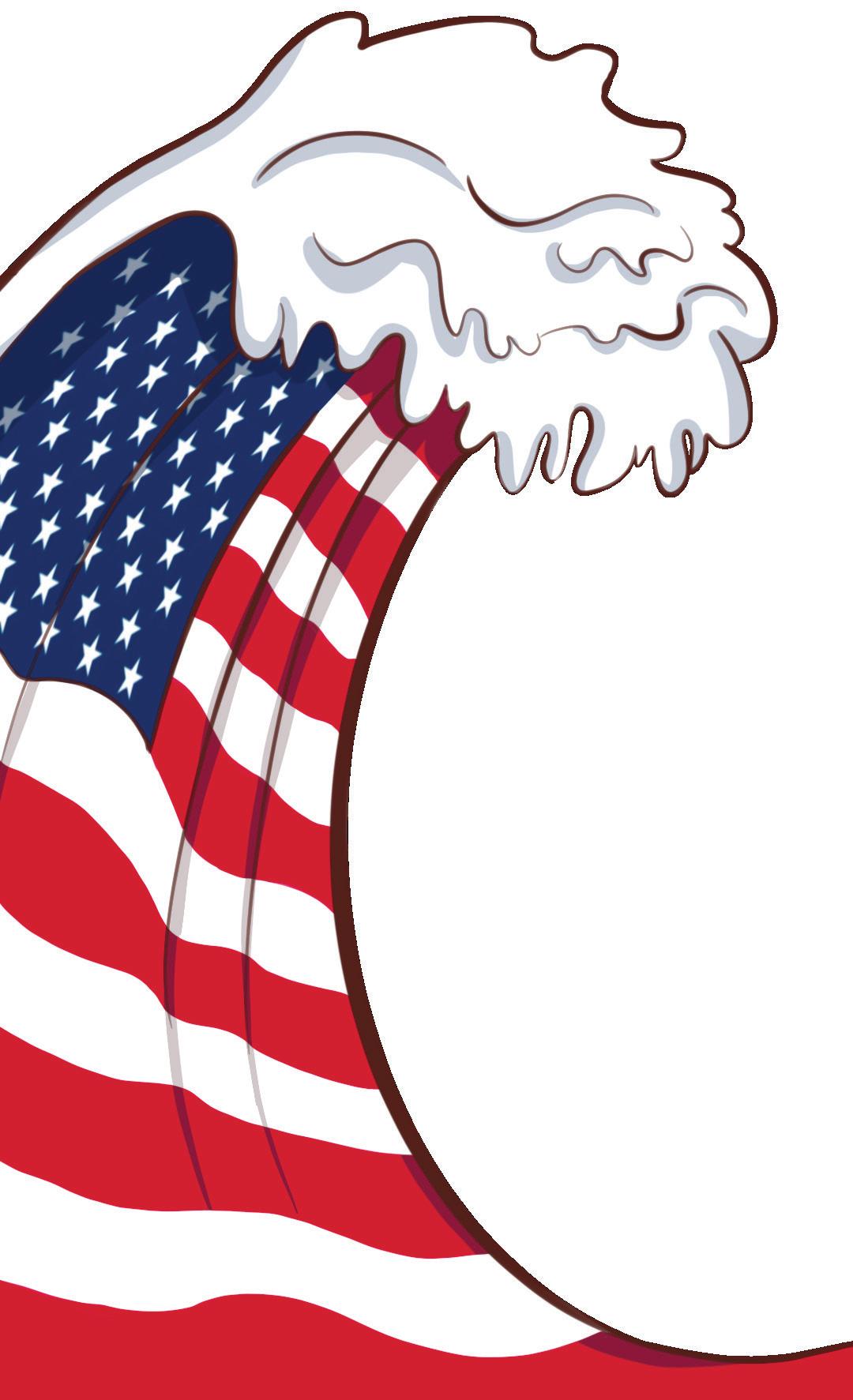
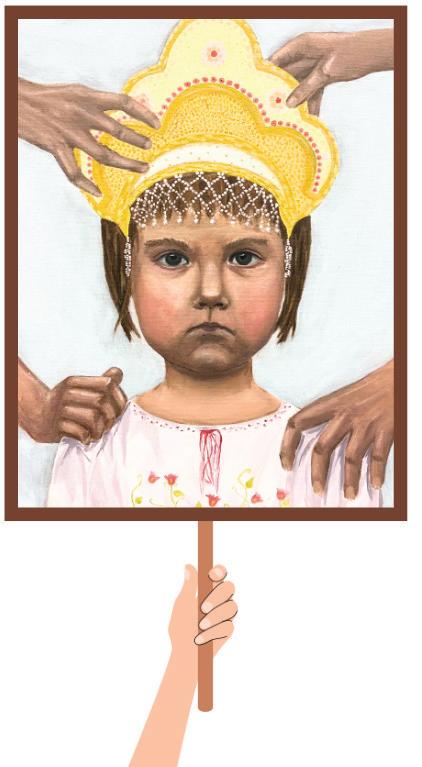
“The dynamic of being Asian American and interacting with my family members, which is one heritage, and going out into the outside world, which has a different culture — the tensions, but also the interplay between that really interests me,” Iris said.
She often includes pinyin, the romanization of Chinese words, to
both their heritage and the surrounding culture as integral parts of who they are.
For many children of immigrants, pursuing art isn’t always encouraged. In families where stability is prioritized, creative careers may be seen as impractical. The sacrifices of prior generations may influence youth to follow in their parents’ footsteps.
“My family is all immigrants, and we’re grappling with the weight and also the partial loss of history that occurs when we migrate to a new land,” Iris said. “Sometimes conversations with my family members about the idea of tradition versus following my own path influence me and my writing.”
One organization working to support young artists with immigrant backgrounds is ARTogether, a nonprofit that provides art programs for immigrant and refugee communities. ARTogether director Michelle Lin recognizes that one of the biggest barriers to young artists isn’t just external. It is also rooted in inner struggles with cultural identity and self-assurance.
“There are a lot of resources immigrant and refugee artists have additional obstacles towards,” Lin said. “They’re trying to figure out how to get

PUZZLE PIECES Sophomore Vera Sorotokin’s paintings reflect her divided identity, grappling with her dual Russian and Ukrainian heritages POIGNANT PROSE
Senior Iris Cai uses this line from her poem “Painted Bodies We Give Up” to capture the complexity of the Asian American experience.




Beli facilitates restaurant selection through personalized tracking

DINE
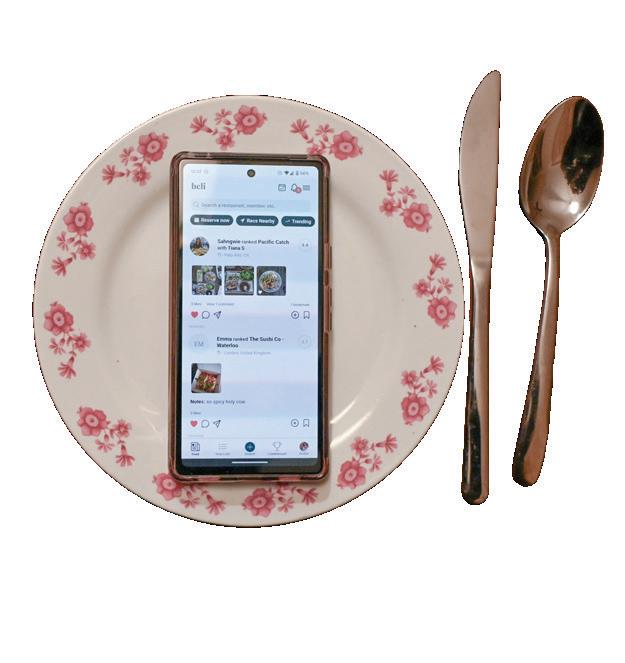
helps users decide what restaurant to dine at by connecting with friends and viewing their ratings and recommendations. Users can also rank and track all of the restaurants that they have visited for future reference.
When it comes to picking a restaurant, my indecision always wins out. A seemingly trivial choice leads me into a spiral of decision paralysis in which I always circle back to the same few familiar options.
That is, until I discovered Beli. Beli allows users to track and rank all of the restaurants they have visited and receive customized recommendations, all while connecting with their friends. A combination of Yelp, Pinterest and Instagram, the app provides a space to discover new spots and also share dining experiences.
“A combination of Yelp, Pinterest and Instagram, the app provides a space to discover new spots and share dining experiences.
As someone who’s frequently overwhelmed by options and struggles to try new restaurants, Beli has made branching out of my comfort zone accessible and enjoyable. The app preserves all of the community oriented aspect of food culture with its social media-like feel, where users can like and comment on their friends’ latest restaurant visits.
While other food reviewing platforms can feel impersonal, filled with strangers and random comments, Beli creates a more intimate environment where every review and photo comes from people I know.
I look forward to finding a new restaurant to add to my Beli now whenever I eat out. Even if I did not enjoy the restaurant experience, I feel eager to log the low rating to continue curating my suggestions.
When it comes to adding a new ranking to my Beli, what motivates me most is seeing my friends’ likes and comments on my post. Every time I log a restaurant, attaching images, noting my favorite dishes and tagging who I ate with, I am excited to know how my friends relate to or disagree with my experience at the restaurant.
Beli transforms the restaurant decision process from exhausting to exciting — the app turns every meal into a new adventure. So next time anyone asks me where we should eat, I have my answer within seconds: “Let me check my Beli.”
Visit harkeraquila.com for more.
Hair grows everywhere on the body — while it looks most apparent on the head, a thin layer of hair covers the arms, legs, face and torso. For many women, this natural body hair is seen as unhygienic, something to be covered or removed.
“In general, women are not supposed to have body hair. They’re supposed to be smooth, pristine, have an almost doll-like kind of quality to
invention and subsequent marketing of the safety razor in 1904, hair on women was portrayed in the media as masculine. Women started to shave their body hair due to the new fashion of sleeveless tops and dresses which emphasized bare arms and legs.
Now, body hair removal remains popular with various forms of removal including shaving, waxing and threading. Recently, influencers popularized laser hair removal on social media platforms.
Carla claimed, “This is why Disney is about to loose $300 million.”
This post echoed a similar controversy from 2021 during the premiere for the trailer of the game Horizon Forbidden West. In this game, female character Aloy was rendered realistically with some peach fuzz on her face. Many internet users did not think this portrayal was natural, and one posted, “Can you explain to me why Aloy has a beard?” The reactions emblemized a misunderstanding of body hair.

These beauty standards do not pervade only in the west. Senior Tiana Salvi speaks to her experience being raised in an Indian culture.
“At least in what I’ve experienced, the stigma is pretty prevalent in many cultures,” Tiana said. “For Indians, we have thicker hair. If I have thick hair on my head, I’m bound to have thicker black hair on my arms; all of that comes with the package.”
Tiana chooses to not remove her body hair because she generally wears long sleeved clothes. However, she often sees people who feel forced to shave due to society’s standards.
“It’s not a routine for me,” Tiana said. “If you do it of your own volition, that’s totally fine. It becomes an issue when people feel like they need to do it or else they feel gross. People should be more understanding of how we don’t always have 20 minutes to shave our legs — it’s a lot of work.”
This expectation of women to constantly keep up appearances adds to the view of women as objects of desire for men.
“Objectification is the best word for it,” Gilbert said.
“We talk about this in art history, going back all the way back to the Madonna image in the Christian world, this perfect, unscathed, virginal aura that you’re supposed to aspire to.”
In an age of relentless academic competition, a new trend has emerged — one that glorifies excessive studying and productivity at all costs. “Study with me” videos and time-lapse clips of students working for hours on end have taken over platforms like YouTube and TikTok. While these videos were originally intended to provide motivation and community, they have contributed to a culture where breaks are seen as failures and rest is equated with laziness.
The phenomenon of toxic productivity — where individuals feel pressured to be constantly working — has gained traction among students striving for top grades. The pressure to keep up has led many to sacrifice sleep, social interactions and even their mental health in pursuit of academic perfection. Sophomore Ritisha Chakravarty struggles with being able to stop studying.
“I find myself watching study streams and feeling guilty if I’m not working,” Ritisha said. “Even when I know I should take a break, I feel like I’m wasting time. Studying has become something I do compulsively, even when I don’t need to.”
This constant pressure to study stems not only from social media but also from deep-seated societal expectations. Productivity is often rewarded, while taking time to rest is dismissed as a lack of ambition. The problem is compounded by the competitive nature of academic institutions like Harker, where students often compare their progress against their

peers and feel the need to outwork each other. Roshan Amurthur (11), president of Neuroscience Club, recognizes the dangers of overstudying yet finds himself caught in the cycle.
“Sometimes, even I fall into the trap of overstudying,” Roshan said. “I convince myself that pushing through exhaustion will make me more productive, but in reality, my brain suffers. Overloading myself with information doesn’t make me smarter — it just makes me more burned out.”
Psychologists warn that chronic overworking can lead to serious consequences. Study skills advisor Jenny Achten emphasizes that methods of studying vary in effectiveness among most students.
“Constantly trying to work is a recipe for being miserable and your life feels like a grind,” Achten said. “Students need to experiment for what makes them feel good and feel productive.”

8 in 10 people feel their work is not enough
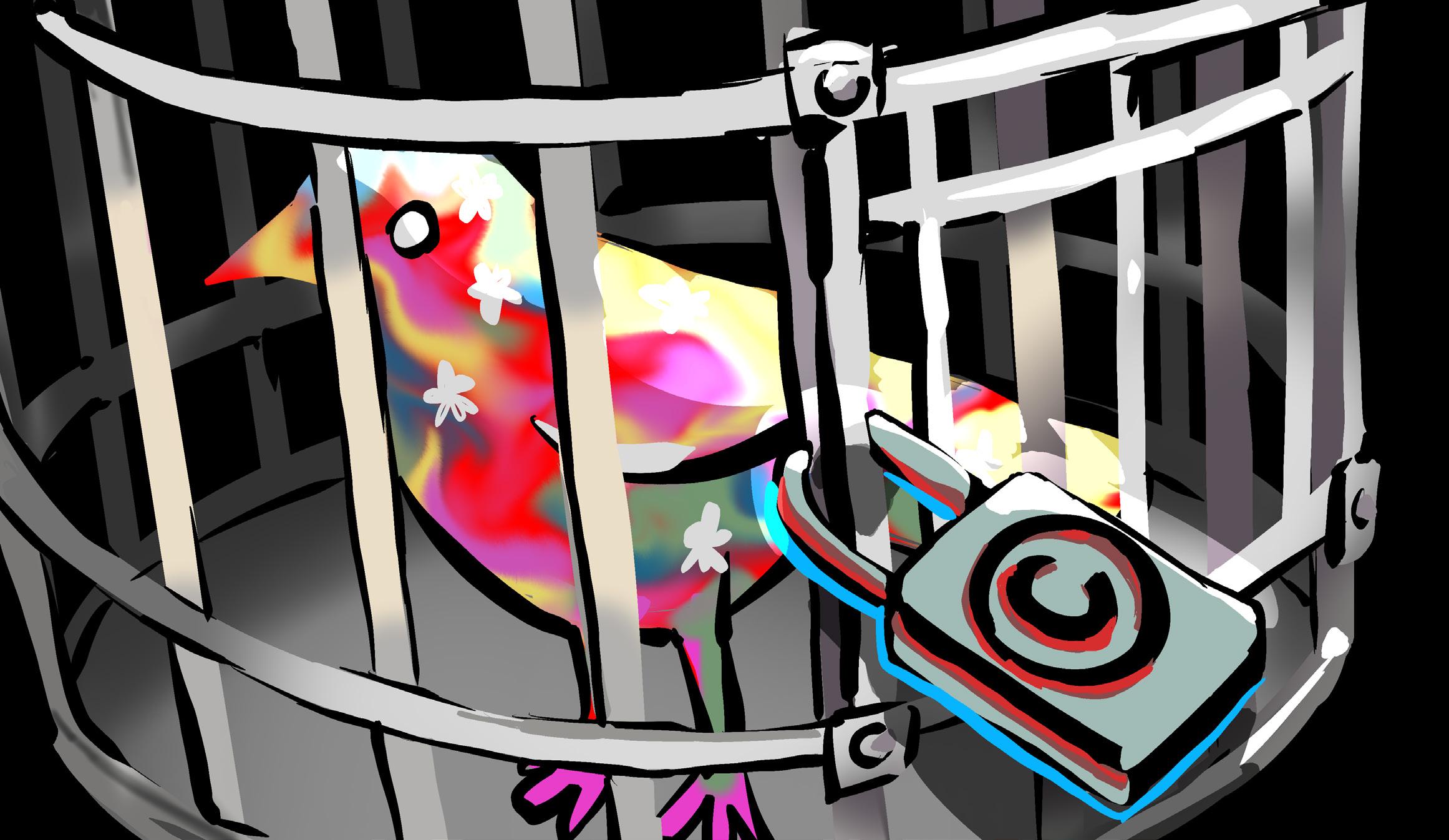
Two thousand and seventy-two.
That’s when the first Star Wars movie, “A New Hope,” will enter the public domain, allowing fans to finally create their own projects with the original iterations of legendary characters like Luke Skywalker and ObiWan Kenobi.
They will not be able to publish a new lightsaber duel between Jango Fett and R2-D2, for example, until 70 years after George Lucas passes away — Jango Fett was created in 2002, and works created after 1978 are protected for “a term lasting for the author’s life plus an additional 70 years.”
Although America’s copyright laws are necessary, they go beyond the point of simply protecting intellectual property. Policies actively work to limit creative expression by making it prohibitively difficult for creators to reimagine or take inspiration from past works.
With the exception of the few files shared under open licenses like Creative Commons, most people looking to distribute work based on copyrighted media have to either obtain permission from the copyright holder or justify their usage of copyrighted material under the fair use doctrine (or wait for the work to enter the public domain).
Fair use can be used as an affirmative defense to a copyright infringement lawsuit, meaning that people accused of illegally using someone else’s content can argue that they are using it in a manner that falls under the legal standards. Fair use law generally protects reuse of copyrighted material if the new content is transformative, doesn’t take too much from the original and doesn’t harm the market for the original. Additionally, reuse of factual content is preferred over reuse of fictional content.
These four factors all intuitively make sense, and the interpretation of fair use should be expanded to combat
growing copyright protections that stifle creativity. Fair use laws encourage people to create content that is genuinely original and explores new perspectives, and the whole goal of the copyright system is to support creativity.
Copyright laws were initially developed to support inventors and artists looking to monetize their work. Without them, it would be much more difficult for scientists, developers and other creators to profit off of their ideas. Companies with only profits in mind could simply copy successful products and pass them off as their own, reaping the rewards of others’ work.
Consequently, totally eliminating copyright laws is illogical, as that would significantly disincentivize innovation. Shortening the duration of copyright protection and making fair use protections more robust would instead be a better way to protect creative works while still allowing people to reinvent what others have made.
isabella lo
Kanye is undoubtedly one of the greatest and most influential artists of our time. His work is universal; there is not one person who won’t recognize hits like “Runaway” or “Graduation.” Yet without a doubt, he also holds the title of one of the most controversial figures in the mainstream, from his stream of Twitter rants to his clothing to his media antics. How do you reconcile both aspects of such a personality? His greatness is undeniable, but so are his racist and harmful remarks. But both come together in his art. Parts of his beliefs and opinions will inevitably seep into his work. This mesh of creativity and personality is what defines art as an expression of self, as a unique contribution.
“If we were to only learn from seemingly morally perfect artists, the world would be a bland place. If we cancel a piece of art, we hobble our own ability to expand off it.”
By
to
speak to. His relevance makes his words impactful and hurtful, and as we build on the hype and clout of his music, we enable his ability to have an impact and implicitly support his remarks.
These factors contribute to the impossibility of separating art from the artist, but I still believe that it is vitally important to do so. Condemning a piece of art solely on the basis of an artist stifles creativity and imagination. Art builds off of itself; artists are inspired by what others have made, musicians sample previous work, and writers learn from recognizing past literature.
If we were to only learn from seemingly morally perfect artists, the world would be a bland place. If we cancel a piece of art, we hobble our own ability to expand off it. The intrinsic value of the art and its potential to improve the world around us should take precedence over a critique on an artist’s individual flaws and mistakes. Should JK
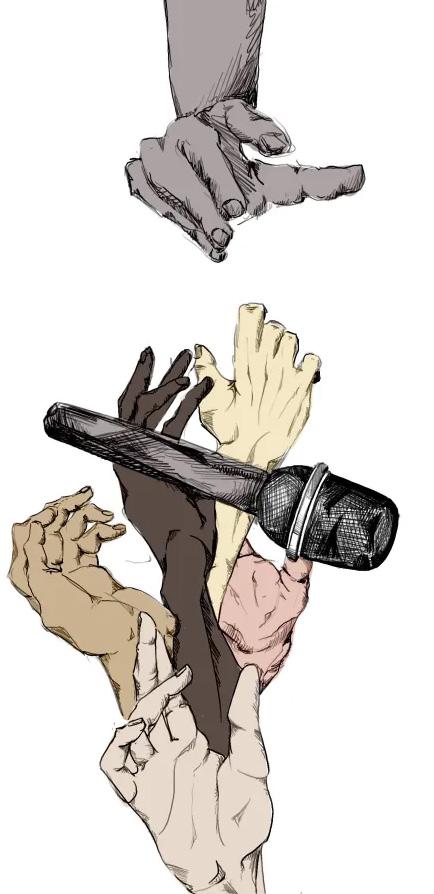
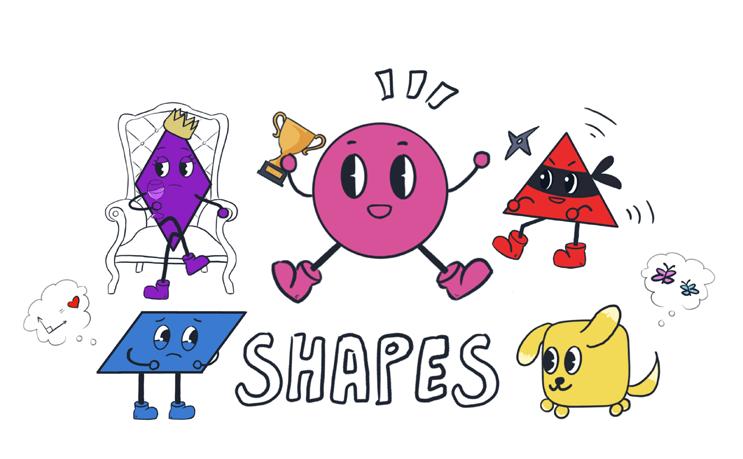
I sit in front of my canvas, racking my brain for what to paint. To break out of my creative block, my mind wanders to a world where I imagine shapes as people. What if shapes had personalities? Here’s a ranking of my top 2D shapes based on the personalities I imagine them to have.
5. Parallelogram
Parallelogram looks at Rectangle. Parallelogram wants to be one. Yet, why does Parallelogram lean when it stands and slant when it tries? It’s always a little crooked, a little off. But Parallelogram has dreams. It straightens its edges. Maybe today will finally be the day to become Rectangle. But the moment it lets go — Parallelogram is right where it started. Parallelogram groans and leans into the slant. Maybe this is just who it is. Maybe it’s okay to be a little off. At least Parallelogram’s area is base times height, just like Rectangle, right? I just admire Parallelogram’s mindset.
4. Rhombus
Rhombus is royal. Rhombus wears purple. Rhombus is pompous. There’s just no one like Rhombus. Rhombus is just too good for anyone — except those who meet its level. Square? Boring. Star? Try-hard. Diamond? Now we’re talking. Rhombus doesn’t sit, but lounges on its throne, sipping something fancy. Rhombus doesn’t tilt like Parallelogram. Rhombus is Rhombus, perfect at every angle. Although it’s got some personality… it’s not the nice type. Rhombus is too busy looking important and just waits to be admired. Rhombus may shine, but he stays at number four.
3. Squircle
Rowling’s transphobic views or Michael Jackson’s sexual assault accusations negate their work and impact? They diminish my opinion of these artists but not my opinion on their art. I believe that an appreciation of art does not necessarily mean support of an artist. I can credit Kanye’s genius or Rowling’s storytelling without condoning their actions. Great art deserves to be recognized as great art, but recognition does not equal support. A more nuanced and insightful approach involves understanding the context and controversy behind an artist, building a deeper level of interpretation on a work of art.
Although I take this approach to art, I do not believe that it’s a one size fits all tactic. Each situation bears its own unique fruits and pitfalls. In cases where the transgression is directly tied to the art, I can’t justify an appreciation of their work. Ultimately, while I still listen to and enjoy Kanye’s music in spite of his actions, I recognize his flaws as a person.
Squircle sits somewhere, not quite round, not quite square. Squircle just wobbles wherever it goes. Squircle just tumbles, no worries at all! It’s a fluffy ball of geometric confusion, bouncing through the world on paws so pristine. Squircle just exists with no care in the world. When the sun is out and the weather is clear, Squircle runs and chases butterflies. When the rain pours, Squircle lays like a bean under a tree. Squircle’s just so cute, and that’s why he’s three!
2. Triangle Triangle. Sharp. dangerous. The ninja of shapes. Triangle flies through the air. Triangle cuts diamond in half. But Triangle’s a bad ninja. It tries to sneak, but it goes thump thump thump. Shuriken? Too pointy. Stealthy? Trips on its own acute angle. Smoke bomb? Blew up too soon. Triangle sighs and just leaves through the door. But its imperfections are what makes Triangle perfect. He’s funny, and I’ll give him points for that.
1. Circle
Circles, circles, circles… Where do I even begin? Round and round my thoughts go.
What do I love about circles? Well, I can hold a circle in my hand with no pain. With round edges, it’s smooth and resilient. Put two circles together, and it makes an infinity with infinite sides. Isn’t that infinitely interesting? Also, Circle doesn’t walk. Circle rolls. Circle’s always on the move, never sitting still. As I watch Circle bounce away, I can’t help but think, “Wow, I love circles.”

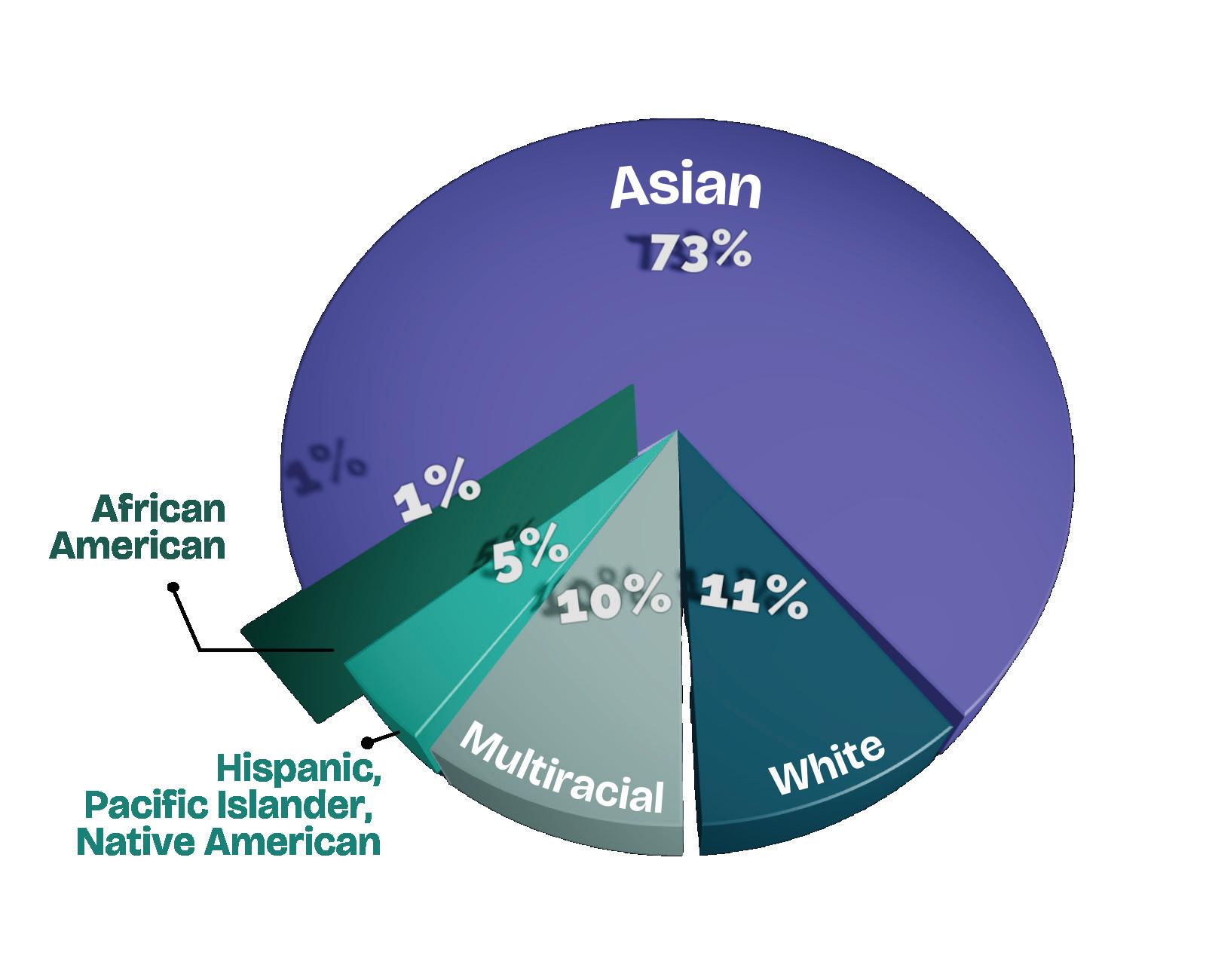

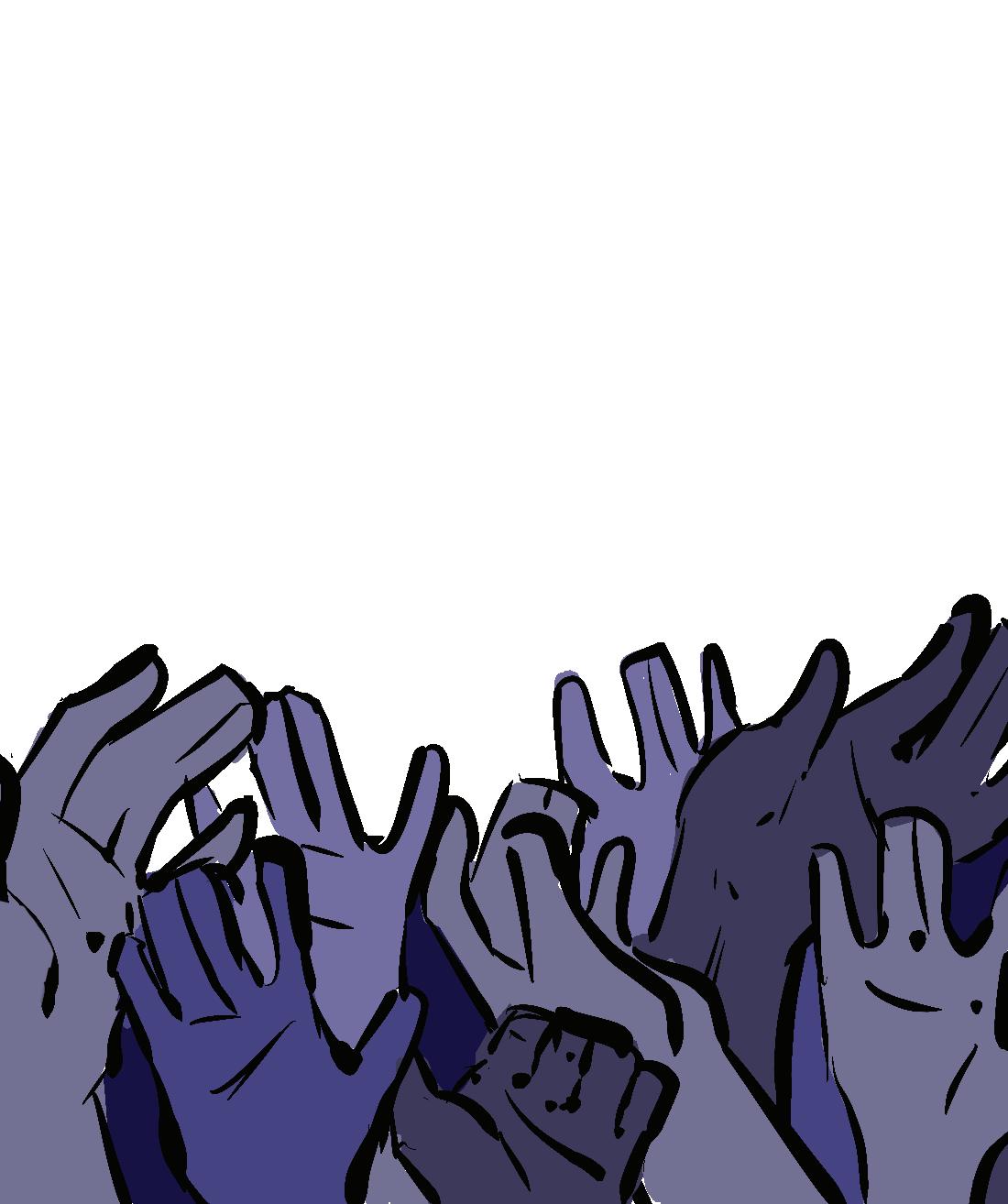
Proportionof student body per racial/ethnicgroup SOURCE: NICHE

aryana bharali
One-point-four million likes. The screen flickers, replaying a slow-motion edit of Gypsy Rose Blanchard shortly after her release. A Nicki Minaj song pulses in the background, the beat synchronized to the rate of the clips. I tap the comments, hoping to see just one person questioning this spectacle. Instead, I’m met with an endless column of praise. “She slayed.” “Gypsy Rose is that girl.” I think to myself, “Since when did murderers become pop-culture icons?”
True crime is undoubtedly one of the fastest growing genres of media. It lures millions into its web of real-life horrors, especially with the recent surge of Netflix sensations like Monster: The Jeffrey Dahmer Story and Monsters: The Lyle and Erik Menendez Story. People flock to these stories for a plethora of reasons, whether it be informing themselves of tragedies, seeking justice for victims or even to stay vigilant in an unpredictable world. But the truth is, most aren’t tuning in for consciousness. They’re tuning in for the thrill.
I’ve kept myself in the loop of true crime for years, feeling a responsibility to confront and acknowledge the darker sides of humanity. Yet, as I’ve observed the media’s reaction to these cases, I’ve become increasingly unsettled by how online viewers lack basic human decency toward the unfortunate victims of these crimes.


desensitizing themselves from the very real violence that lies within them. Among many relevant examples is the case of travelling influencer Gabby Petito, whose tragic disappearance and death triggered viral videos across various social media platforms. Instead of lamenting her loss, users treated it like their own murder mystery to solve. While the fan-driven involvement persuaded authorities to prioritize the case, it also introduced a frenzy of speculation that unnecessarily pressured
evident in how content creators present these cases, often complementing tragedy with entertainment. By casually narrating gruesome stories while doing makeup or indulging in mukbangs, they completely disregard the magnitude of crimes by reducing them to easily digestible, marketable content.
But who’s at fault here? The viewers who binge-watch crime content? Or the content creators who prioritize shock value over truth? Responsibility
gravitate towards sensationalizing it. True crime will be eternally enthralling, a constant reminder of the extent of peoples’ capabilities and wicked mindsets. We, as viewers, have complete control over how we engage with these stories. Therefore, we must decide if we choose to engross ourselves in the internet mania that manipulates them or approach them with the gravity they deserve. Visit harkeraquila.com for more.

Twitter, Instagram, Snapchat, even Facebook: they’re all social media platforms that people use constantly, and it’s incredibly easy to get lost in them. One scroll turns into another, and before you know it, hours have passed, often leaving you feeling worse than when you started. Then there’s Goodreads, with its outdated user interface, slow loading times and eyesore of a tan color scheme. Despite that, there’s something comforting about it, something missing from the slick, hyper-optimized platforms we’re used to. Goodreads has that old-school charm, where it’s not about mindlessly scrolling but about savoring the books you’ve read and finding new ones to dive into.


cat; however, many other readers saw his eventual care for the cat as symbolic of his growth as a character. It was fun to see my view more articulated than I could have done myself and mentally spar with the rebuttals I disagreed with.
loud or nodding in agreement. It’s also a great way to gauge whether a book is worth my time, especially when deciding between titles. Reading reviews after finishing a book is also interesting; I’m always intrigued by how others formulate their opinions. Reviews often have links to interviews and history about the novel I wouldn’t have found myself.
After finishing a book, I spend a fair chunk of my time scrolling through the one and five-star reviews, sometimes diving into the comments sections to follow the discourse of fellow users.
My favorite discussion was about Fredrik Backman’s “A Man Called Ove”, where there was a community of readers arguing that Ove, a grumpy old man, was a horrible person for mistreating a
Beyond reviews, Goodreads offers practical features for organized reading. One of my favorite tools is tracking what I’ve read. I used to forget what I’d finished months ago, but now I can look back at my reading history. It’s like a library that I can carry with me. Plus, when I leave ratings and reviews on each book, I can look back on them and remember how I felt about a book.
Goodreads also lets me set reading goals which keep me motivated. It’s really satisfying to see my progress visually. I love having a number to strive for each year: this year and the last, I set a goal of 100 books. After surpassing that goal, I felt so proud. Setting these goals has inspired me to read more often and more intentionally.
At the end of each year, Goodreads presents users with “Your Year In Books,” a summary of their reading activity. I ended up reading 112 books last year. It was incredibly rewarding to scroll through all the books I’d finished and compare my first and last reviews of the year.
Goodreads also fosters social interaction. I love seeing when my friends hit their reading targets, and they do the same for me with the handy-dandy “like” button. This shared enthusiasm creates a sense of community. When a friend posts about finishing a book I’ve been wanting to read, it pushes me to check it out. There’s a positive kind of peer pressure that keeps me reading.
It’s easy to get stuck in a reading slump, but Goodreads helps me discover books that match my interests. Based on my highly-rated books, the platform suggests new titles, introducing me to great reads that I might have missed.
Of course, there’s the ability to keep track of books I want to read. With Goodreads, I can add them to my “Want to Read” shelf and always have a running list I’m excited to read.
Goodreads stands out because it doesn’t try to be anything it’s not: it’s not flashy, it’s not trying to sell me anything or bombard me with notifications. It simply lets me catalog the books I’ve read, discover new ones and chat with people who share my passion for literature. It might not be the best-looking app, and it certainly doesn’t follow trends, but that’s exactly why I love it, and why I believe everybody should give it a try.
Visit harkeraquila.com for more.

Editors-in-Chief
Victor Gong Katerina Matta
Managing Editors
Young Min Jessica Wang
Claire Zhao
Editor
Lily Shi
Assistant News Editors
Samuel Tong Lily Peng
Chelsea Xie
Features Editors
Janam Chahal Mendy Mao
Assistant Features Editors
Caden Ruan Elizabeth Zhang
A&E/Lifestyle Editors
Suhani Gupta Disha Gupta
Assistant A&E/Lifestyle Editors
Lindsay Li Cynthia Xie
Opinions Editors
Mihir Kotbagi Emma Li
Assistant Opinions Editors
Leah Krupnik Risa Chokhawala
Ashley Mo
Jonathan Szeto STEM Editors
Assistant STEM Editors
Claire Tian Nathan Yee
Sports Editors
Eva Cheng Tiffany Zhu
Assistant Sports Editors
Wenjie Zou Sam Li Claire Xu
Senior Copy Editor
Saahil Herrero
Copy Editor Jeremy Peng
Assistant Copy Editor
William Jiang
Photo Editor Kairui Sun
Multimedia Editor
Charlie Wang
Assistant Multimedia Editor Lindsay Li
Adviser
Whitney Huang, CJE
Aquila Editors-in-Chief
Alison Yang
Emma Milner
Aquila Managing Editors
Hima Thota
Aishani Singh Isabella Lo Gabe Sachse
Charlize Wang
Humans of Harker Editors-in-Chief
Sidak Sanghari
Jonathan Xue
Humans of Harker Managing Editors
Ella Guo Aryana Bharali
Humans of Harker Profilers
Heather Wang Vivek Moorjani
Victoria Li
Reporters
Mirabelle Feng
Ram Batchu
Samaara Patil Emma Lee
Sarah Wang
The Winged Post is the official student newspaper of Harker’s upper school and is distributed free of cost to students every four to six weeks except vacations by the Journalism: Newspaper and Advanced Journalism: Newspaper courses at The Harker School, 500 Saratoga Ave., San Jose, California 95129. We aim to publish balanced stories following professional standards while serving as a public forum for Harker students. All content decisions are made by student editors. Opinions and letters represent the viewpoints of the writers and do not necessarily reflect the opinions of The Winged Post, Harker board, administration, faculty or journalism advisers. Editorials represent the official opinions of The Winged Post editorial board. Letters to the Editor may be submitted to Manzanita 70 or emailed to harkeraq@gmail.com and must be signed, legible and concise. The staff reserves the right to edit letters to conform to Winged Post style, and letters will be published at the discretion of editorial staff. Baseless accusations, insults, libelous statements, obscenities and letters that call for a disruption of the school day will not be considered for publication.
Students hold the copyright to work published in Harker journalism publications.
NSPA Pacemaker Winner: 2019-20, 2017-18
NSPA Pacemaker Finalist: 2024-25, 2023-24, 2020-21, 2018-19, 2016-17
CSPA Gold Crowns: 2025, 2024, 2023 2019, 2018, 2016



EDITORIAL:
“I’m sick.” How often have you heard this from a mask-clad classmate and wondered why they were at school? To many students, this isn’t a rare occurrence: in a recent poll with 176 student responses, 76.1% said they noticed or heard of sickness on campus at least once a week. 90.9% have personally caught an illness from others at school, with 81.3% sick multiple times this academic year. Out of these students, 88.7% said they attended school even while sick.
95.1% of respondents cited schoolwork as their primary reason for going to school while sick. One student wrote on the form, “It’s unfortunate, but it’s the price we pay for productivity.” This mindset needs to change, as it harms both sick students and the broader community.
However, student culture isn’t fully at fault for this unhealthy mindset. Policies regarding attendance compel students
to attend school even when they’re not feeling their best: 53.3% of students said they were concerned about how taking days off would impact their attendance record. Per the Student Handbook, if a student misses more than five days in a semester for any reason besides a school-sponsored trip or activity (this includes being sick), they may lose credit for classes, which could hinder meeting graduation requirements.
Moreover, students must attend 50% of their academic day to participate in any after school programs, such as athletics and performing arts. If a student is absent from a program due to illness, however, they are automatically excused, according to Laura Lang-Ree, Performing Arts Director, and Dan Molin, Athletic Director. After school programs show more leniency toward cases of illness, but the contradicting policies between these programs and academic classes only add to students’ stress and confusion when deciding whether to come to campus.


Welcome to the fifth and penultimate issue of the Winged Post in the 2024-25 school year! This issue marks the final paper produced by the current strategic team before we pass our duties onto the 2025-26 leadership team. It is thanks to the incredible efforts of our reporters and editors that we are able to fill our paper with in-depth content. If someone you know contributed to this issue, congratulate them!
Our coverage in this issue focuses on both the big and the small: from
displaying the wonders of the galaxy with astrophotography to recommending new eats to your friends with the restaurantsharing app Beli, we hope this issue gives you the chance to explore the many nooks and crannies our community has to offer. As always, we’d love to hear your feedback on any aspect of the Winged Post! Feel free to email us at harkeraq@ gmail.com. As our journey comes to a close, we'd like to thank you all so much for reading and supporting our publications. It's been an amazing year putting together each issue, and we can’t wait to bring you more awesome content!
The current attendance policies require more clarity and leniency so sick students can truly put their health first rather than dwell on specific guidelines. However, there also lies the inherent issue of our student culture: the mentality of constant productivity causes students to prioritize showing up to class no matter the cost.
As students, we should rethink our attitude toward attending school while sick. Rather than possibly spreading an illness to others and causing even more stress and discomfort to ourselves by attending school, we should instead focus our efforts on communicating with our teachers and peers about what we’re worried about missing.
Teachers can also help relieve this stress by releasing the day’s class plans or materials online. Having a Zoom option for classes would also allow sick students to tune in if they want the option to stay on top of classwork while keeping the classroom healthy and sickness-free.
NEWS A3: Serbia and Belarus global headlines briefs both trail off midsentence
OPINIONS A5: One instance of “TedED” should be “Ted-Ed”
SPOTLIGHT A7: Demi Zheng incorrectly identified as a junior; she is a sophomore
FEATURES B2: “Get out the vote” caption missing period
OPINIONS A8: Risa Chokhawala incorrectly spelled as "Chokhwala"
A&E B8: Both pull quotes missing periods
CORRECTIONS POLICY:
Our staff strives to represent our community fairly and conduct accurate, truthful storytelling. We list all errors of an issue, along with the page number of that error, in the next issue’s corrections box.
Feel free to provide feedback via the QR code to the right.

Modern medicine has made significant strides in studying women’s health within the last fifty years, but it wasn’t long ago that women’s participation in clinical research was largely neglected. Before the 1990s, medical research often excluded women as clinical subjects. Because the data that forms the basis of healthcare practice was calibrated to male biology, female patients of the past and present have faced higher rates of misdiagnosis, negative side effects to medication and inadequate treatment.
“Historical treatment protocols did not recognize there is a biological difference between the two,” Science department chair Anita Chetty said. “We have everything from crash test dummies, which are modeled after male models, to a scarcity in an understanding of the biology of women.”
Biomedical research tended to understudy physical and psychological conditions that predominantly affect women, like osteoporosis, postpartum depression, breast cancer and eclampsia. Only until around 1985 did this landscape begin a shift, especially with a government report from the U.S. Public Health Service Task Force that identified the widespread health consequences of women’s absence in clinical research, and recommended reform to expand investigation into female health and biology.
“Only recently has there been an awareness of what happens postpartum, and that postpartum depression is actually a thing — and it wasn't until there were some really shocking criminal cases,” Chetty said. “We don't have enough information directly, readily available.”
to include women and minorities as participants, and women are more likely than ever to join.
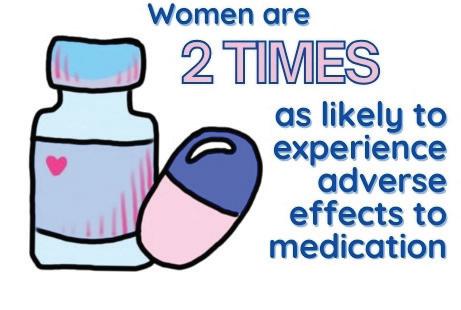


UNBALANCED Female biology was generally overlooked before recent women's movements in medicine.

Public movements have strived to improve demographic representation in clinical trials in the last few decades. Since the National Institute of Health (NIH) Revitalization Act of 1993, federal law has required NIH-funded research
and they seem to be doing a good job.”
Despite recent progress, holes in medical knowledge persist to the present day. Senior Tiana Salvi identified flaws in studies conducted outside of the NIH while writing a report on gender bias in pain treatment. Even when those studies include female participants, researchers sometimes fail to analyze whether the
variable a lot, so there's a lack of literature around it,” Tiana said. “That's pretty significant because women's and men's hormones will affect pain and disease differently.”
For instance, the symptoms of a heart attack present differently in women. This distinction may put them at risk because those symptoms may not be classically associated with heart

They don't regulate the use of sex as an explanatory variable a lot, so there's a lack of literature around it.”
TIANA SALVI (12) STUDENT RESEARCHER
problems, while men' s symptoms are. In light of women's health risks, Chetty encourages students to understand medical bias and contribute to a better future in the research space.
“We are just scratching the surface. Ask, ‘Why is it that these things are still happening?’” said Chetty. “There has to be more consumer or voter-driven influence on research and government officials who we elect — it should be part of their platform to ask these questions.” Visit harkeraquila.com for more.
While gender is often simplified as a binary of male and female, it’s truly more complex than just XX or XY chromosomes. The biological reality of gender involves a complex patchwork of hormones, genes, anatomy and even social behaviors.
Senior Melody Yin, who took Introduction to Women and Gender
Studies and debated on the topic, pointed out that many gender stereotypes evolve over time. Different norms across different centuries contribute to society's understanding of gender.
“Many of the typical signifiers we use to separate gender, like expressions of femininity through high heels and wearing pink for example, are actually quite arbitrary,” Melody said. “In the early 1900s, pink was actually considered masculine and blue was viewed as more feminine. In the 10th century, men would commonly wear heels as a way of symbolizing their social stature or even military prowess.”
Pervasive but arbitrary gender stereotypes operate on the basis of only two genders existing. Such stereotypes further ingrain the understanding of gender as a binary category, excluding individuals who don’t conform to either. Intersex stand as one such prominent group, among others.
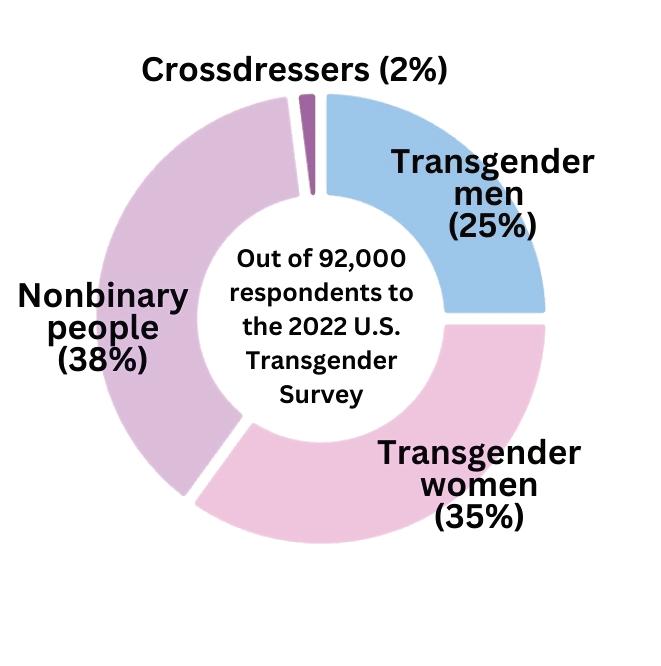
Intersex individuals exist in the spectrum of gender and are born with variations in sex characteristics, like chromosomes or reproductive features, that do not align with typical standards of male or female. Biology teacher and Transgender Affinity Group adviser Eric Johnson emphasized that intersex people are often overlooked and ignored. “Intersex people make up five million people in this world,” Teacher Johnson said. “That’s just the

SOCIETY AND STRUCTURE Typical forms of gender expression change across time periods. “Many of the typical signifiers we use to separate gender, like expressions of femininity through high heels and wearing pink for example, are actually quite arbitrary,” Melody said.
people who are not XX or XY. There are trans people and there are non-binary people, and [you need to] incorporate that personhood into your life.”
In shifting society's perception of gender, Melody noted the importance of recognizing intersex individuals and shedding the mindset of viewing gender as a binary.
“Even something like sex, which people used to think was very binary, isn’t that simple,” Melody said. “Intersex people exist, and it’s important that we recognize that and acknowledge it.”
A variety of regional cultures have continually shown that gender does not conform to binary standards. Visit harkeraquila.com for more.

When you look up at the night sky, what do you see? On good days, stars dot the dark canvas, and on bad days, there’s nothing at all. Yet, behind the occasional constellations lie realms of galaxies, nebulas and colorful assortments of gas and dust, all invisible to the naked eye. For high school student Shanji Shen, capturing these celestial exhibitions constitutes a form of art: astrophotography.
Living in Shenzhen, China, astrophotography allows Shanji to step out of the bounds of his bedroom to peek into the mysteries and wonders of the universe. To him, snapping images of distant space phenomena is much like searching for hidden treasure in the sky, utilizing specialized telescopes and cameras to track and render.
“Deep space photographers take photos of things we usually can’t see,” Shanji said. “We live in big cities where light pollution is serious, and we can’t even see many stars. But with astrophotography, you can capture such beautiful pictures.”
Shanji’s journey in astrophotography began in the bookstore one summer afternoon in 2018, with the book “Night Sky.” Intrigued by the front cover, featuring a photo of a nebula cloud embedded within a sea of stars, he flipped through more pictures and read about astrophotography techniques. Eager to capture such images himself, he bought his first entry-level astronomy telescope,
the Celestron 80EQ, on his 10th birthday.
“Back then, I would run up to the rooftop every day in elementary school to play with [my telescope],” Shanji said. “For example, once during a lunar eclipse in 2019, I used the telescope to take photos and set up my phone to the back of the telescope to shoot pictures of Jupiter.”
“In big cities light pollution is serious, but with astrophotography, you can capture such beautiful pictures.”
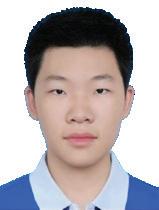
SHANJI SHEN ASTROPHOTOGRAPHER
With just his rudimentary contraption, Shanji managed to snap photos of several planets, including Saturn, Mars, Jupiter and Venus, but that didn’t quite satisfy him. Compared to the mesmerizing gallery of photos in “Night Sky,” Shanji’s pictures came out grainy, blurry and dim.
“The results were really poor because I was using a phone to shoot [through the telescope],” he said. “My setup at home was really simple, so the tracking was unstable, shaking a lot, and the footage didn’t turn out great. It was way worse than I expected.”
Astrophotography, reliant on long exposure, requires precise tracking of
celestial bodies as they shift position in the night sky relative to the lens. Shanji could not achieve a high enough level of stability to take clear shots as he used a phone camera at the time.
To improve the quality of his photographs, he replaced his old 01K with a more advanced Skywatcher EQ6-R telescope and also purchased a mirrorless camera and a 3D equatorial mount for accurate tracking. Although the setup produced clearer images than before, they were still far from the level of detail that professional astrophotographers achieved. Numerous factors, including light pollution and lens limitations, posed challenges to rendering detailed photos. After researching online, he found out that he could modify his camera for astronomy imaging by removing the infrared filter, revealing faint deep-sky objects.
“After [that upgrade], I traveled to a place with even less light pollution — in
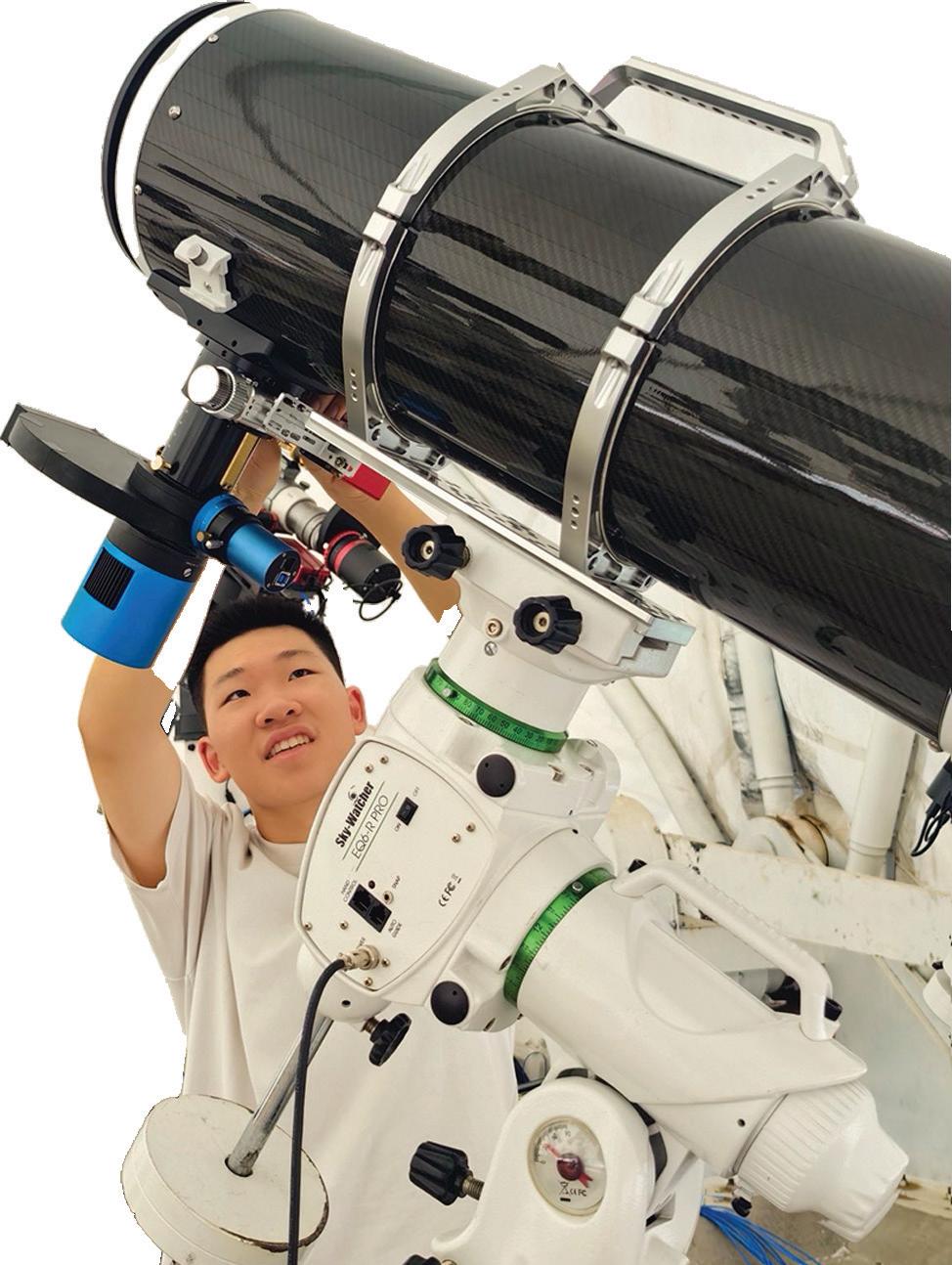
In the past few years, drinks claiming to improve gut health like Olipop and Poppi have appeared all over social media, offering an alternative to unhealthy sodas and carbonated beverages. But what are these probiotic and prebiotic soft drinks, and do they actually benefit your gut?
Probiotics drinks include live bacteria that occur in fermented foods and drinking them directly introduces beneficial microorganisms into the intestines. Prebiotic beverages contain ingredients like sugars and fibers to promote bacteria growth and activity. Manufacturers of these drinks claim that by balancing microbes, the beverages offer benefits to gastrointestinal health, such as reduced inflammation, improved digestion and enhanced immunity.
Both types of gut healthy sodas start with a water as a base as opposed to kombucha, which is tea-based. While prebiotic sodas can be made through the combination of fibers like inulin from chicory roots with carbonation and flavouring, probiotic sodas begin with the preparation of a starter culture.
Chief Executive Officer of The Superfood Company Ben Krysiak
specializes in producing non-dairy kefir soda that relies on fermented kefir grains. He describes the process that goes behind manufacturing each can.
“It all starts with the kefir. It’s a living probiotic, and so it takes some
delicate care to keep it healthy and robust,” Krysiak said. “We always have to maintain our mother stock of Kiefer, and reinoculate the next batch. You go to the mother [stock], add a new tank and feed the kefir. It needs sugars of all types, but
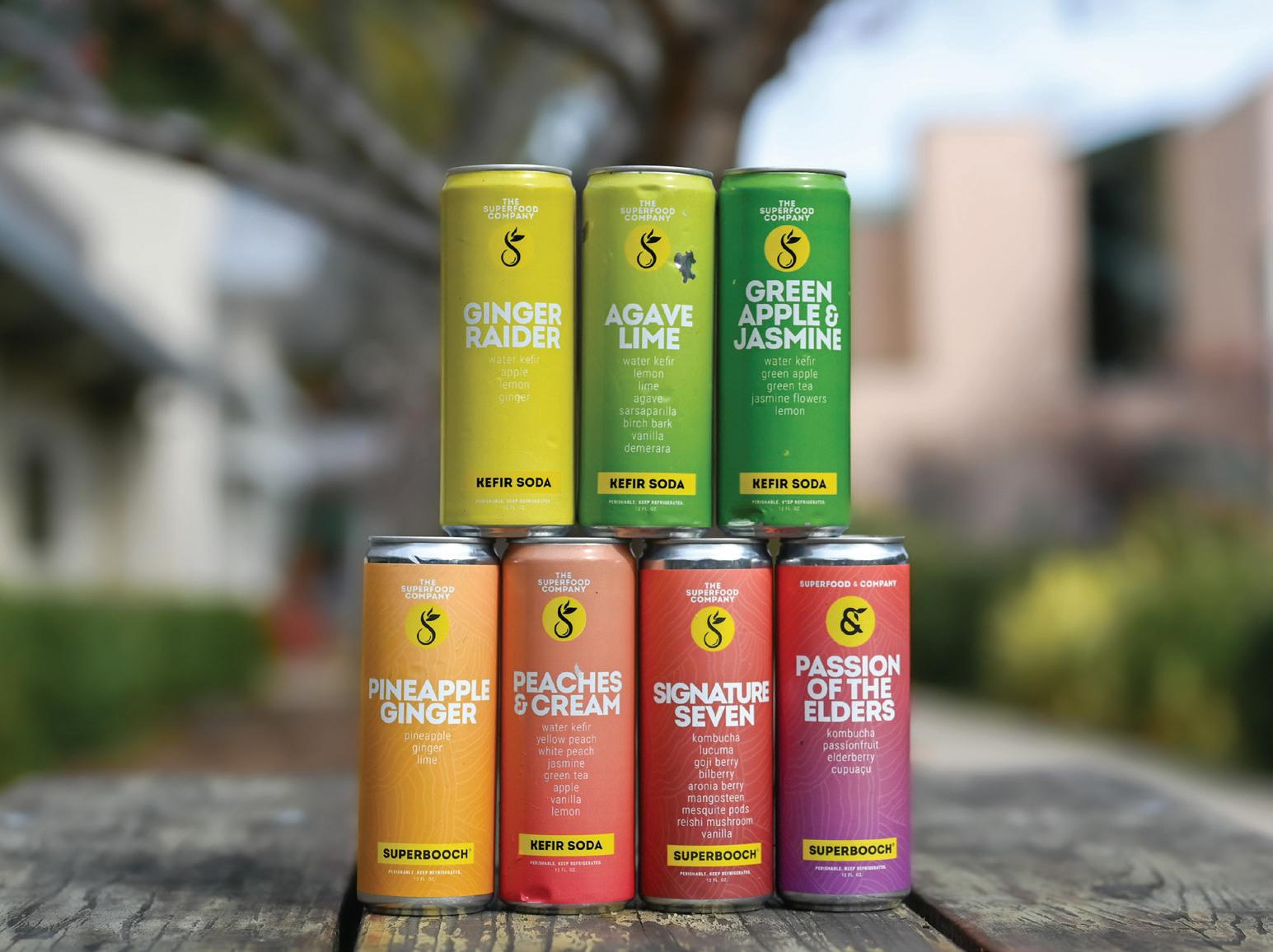
we use an organic cane-based sugar while it’s growing and waiting to be mixed into a drink.”
“ It all starts with the kefir. It’s a living probiotic and so it takes some delicate care to keep it healthy and robust.”

BEN KRYSIAK THE SUPERFOOD COMPANY CEO
Besides containing ingredients to promote gut health, most probiotic and prebiotic sodas utilize fruit juice as opposed to corn syrup, have less sugar overall, contain more fiber and rely less on artificial flavors compared to other sweet carbonated drinks. The soda undergoes carbonation and fermentation after flavoring is added to probiotics. Fermentation methods vary, but often differ from the traditional two-phase procedure used to for kombucha. This makes probiotic sodas lighter and less sour, an alternative to those who find the tangy taste of kombucha less enjoyable. Visit harkeraquila.com for more.

Mourning dove
Zenaida macroura
Range: North America from southern Canada to Panama
Features: grayishbrown bodies, black spots on wings, distinctive doleful call
Behavior: foraging, nesting, raising young

Eastern grey squirrel Sciurus carolinensis
Range: east North America, West Coast cities
Features: dark to pale gray skin and fur Behavior: climbing, build nests high in trees
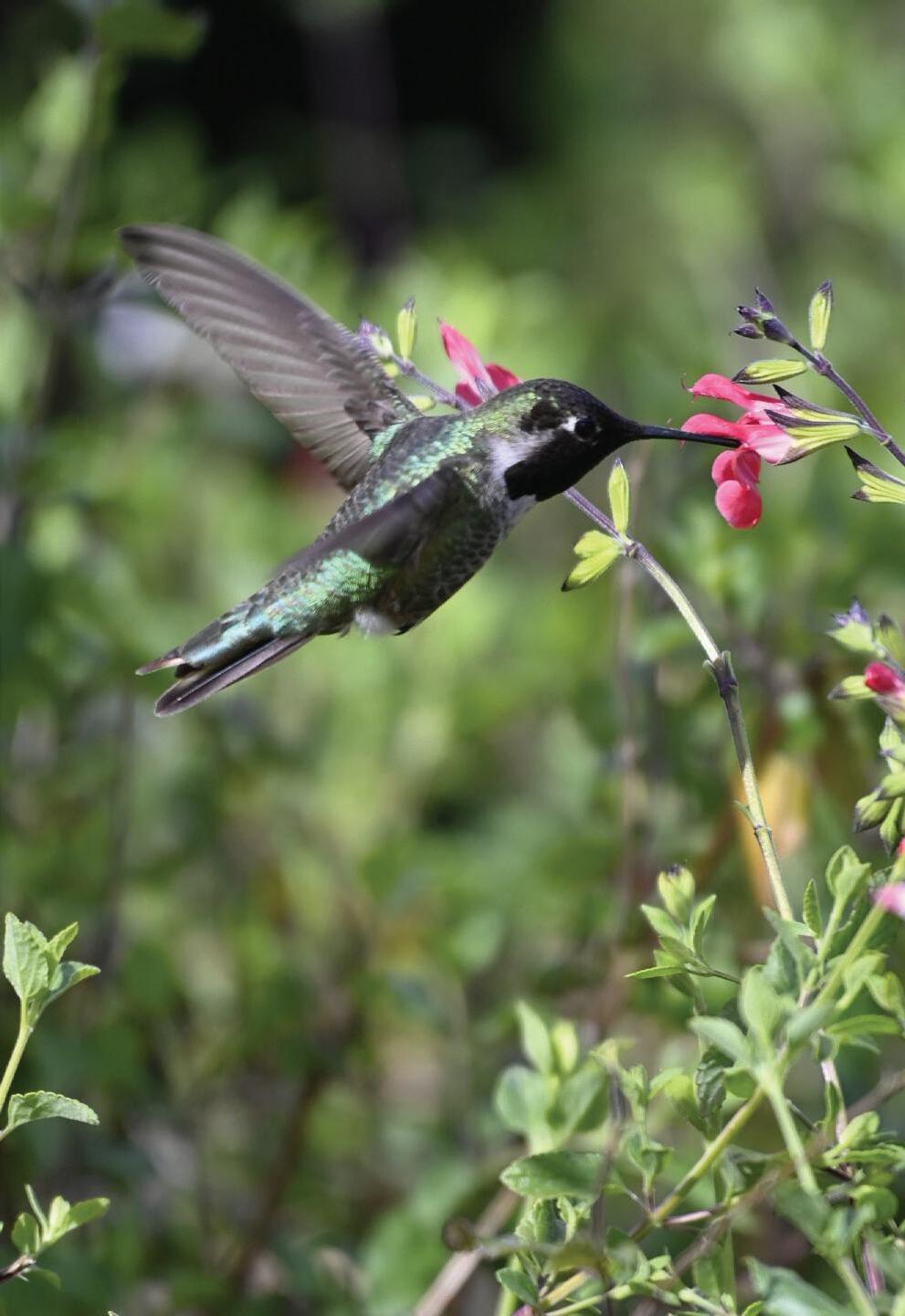
Anna’s hummingbird
Calypte anna
Range: western coast of North America, Arizona
Features: iridescent green backs, rose-pink/red crown Behavior: feeding on nectar, insects, pollinating plants
ashley mo & jonathan szeto

March marks the transition from winter to spring, bringing gradual changes to the campus ecosystem. Despite the colder, more rainy weather throughout much of the month, wildlife activity is increasing, and animals frequent the Quad more often. In the Orchard, flowers bloom in vibrant colors. The five-petaled flowers of Coleonema pulchellum, also known as breath of heaven, resemble bright pink stars, and birds of paradise stand out with their bright orange and deep blue petals emerging from a dark green, beaklike sheath, the spathe.
With the arrival of spring, birds of various colors and sizes also return to the sky. A buzzing female Anna’s hummingbird, with an iridescent green back, hovers in the air and uses her long tongue to feed on nectar at every flower she visits. She also catches small insects
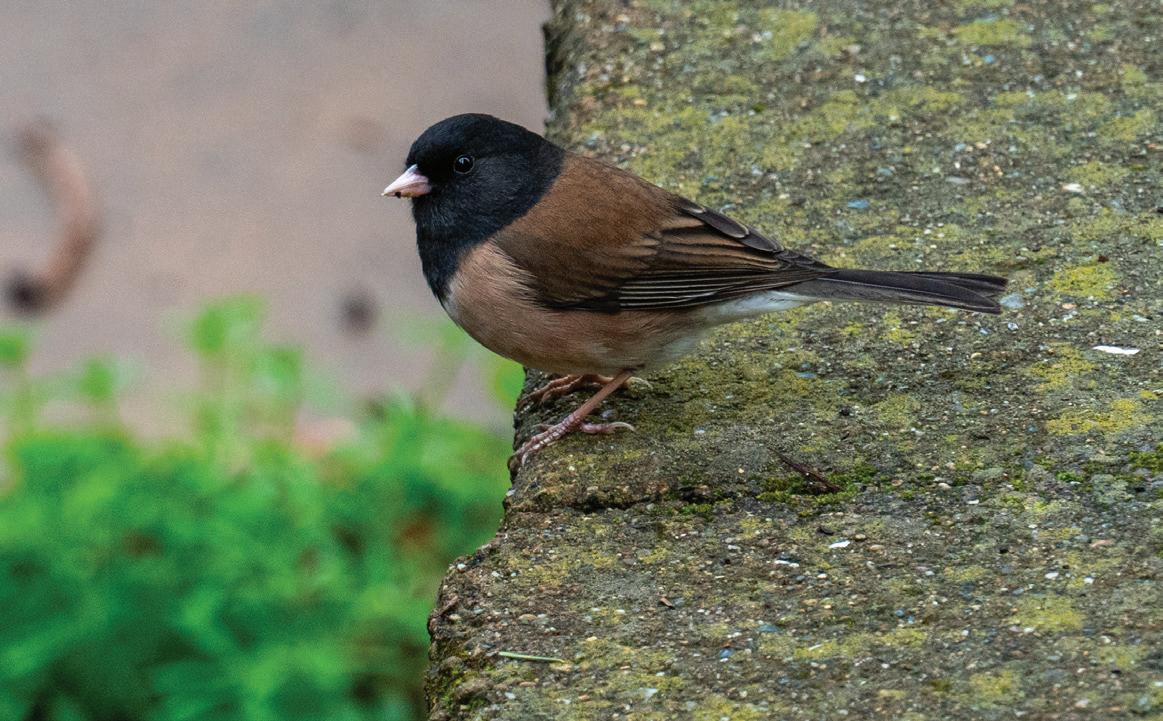
Dark-eyed junco Junco hyemalis
Range: entirety of North America
Features: light brown back, long tail Behavior: hopping, foraging

Bird of paradise Strelitzia reginae

Breath of heaven Coleonema pulchellum

Star tickseed Coreopsis pubescens
from midair to feed to her young back at her nest. Meanwhile, on the ground, a dark-eyed junco forages by jumping around in a doublehop scratch dance. He first scrapes his feet backward against the dirt to remove the surface layer of the soil and then forward to kick up seeds hidden underneath.
In tall treetops, mourning doves coo in search of potential partners. Eastern grey squirrels can be commonly seen scurrying on the ground and up and down trees. Despite their name, the color of these squirrels range from black and brown to even white as a result of genetic mutations such as melanism, which causes dark fur, and albinism, which leads to white fur. Some rest on high stumps overlooking the Quad, keeping an watchful eye on their surroundings. They gather fruits, nuts and seeds to store and to feed their young.
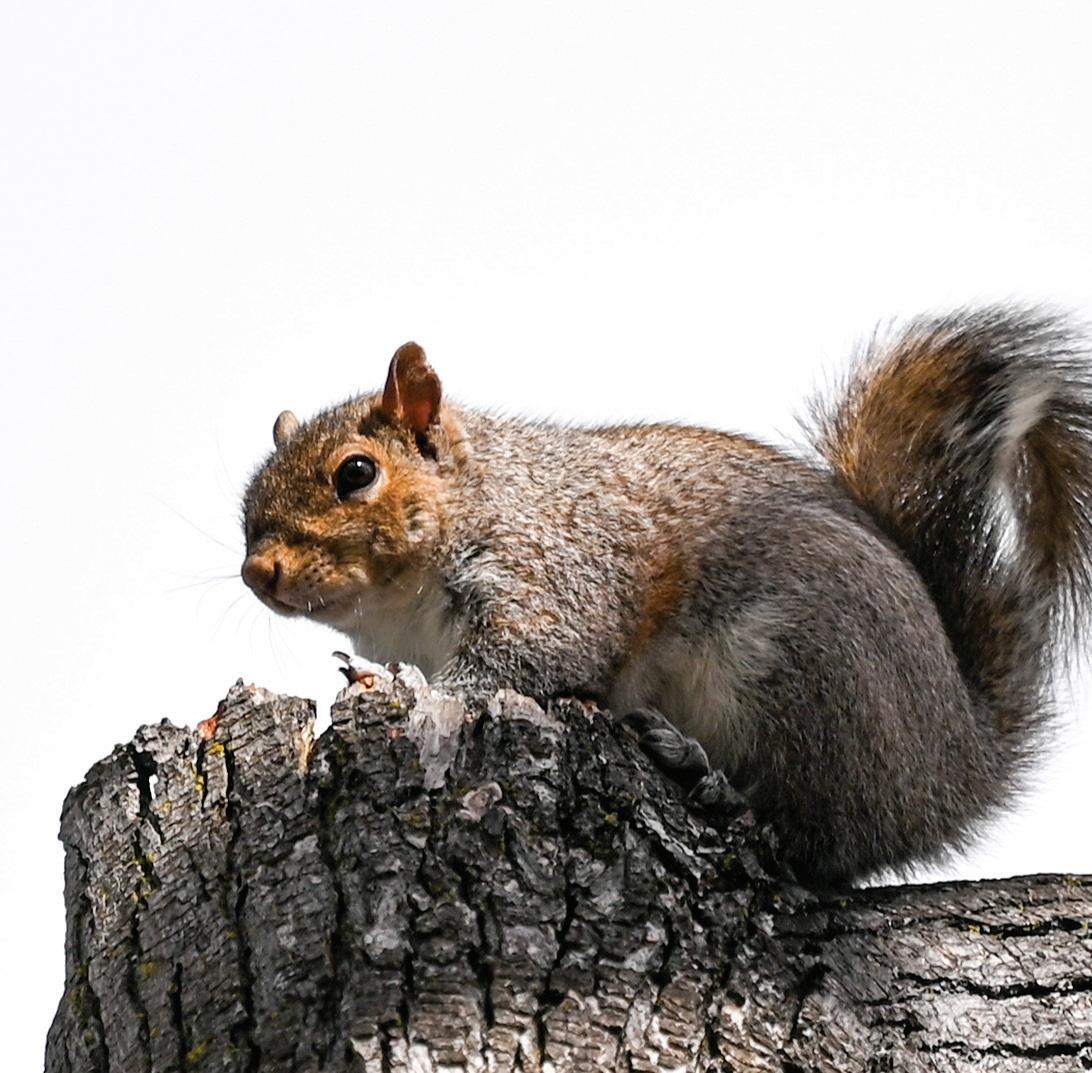
Eastern grey squirrel

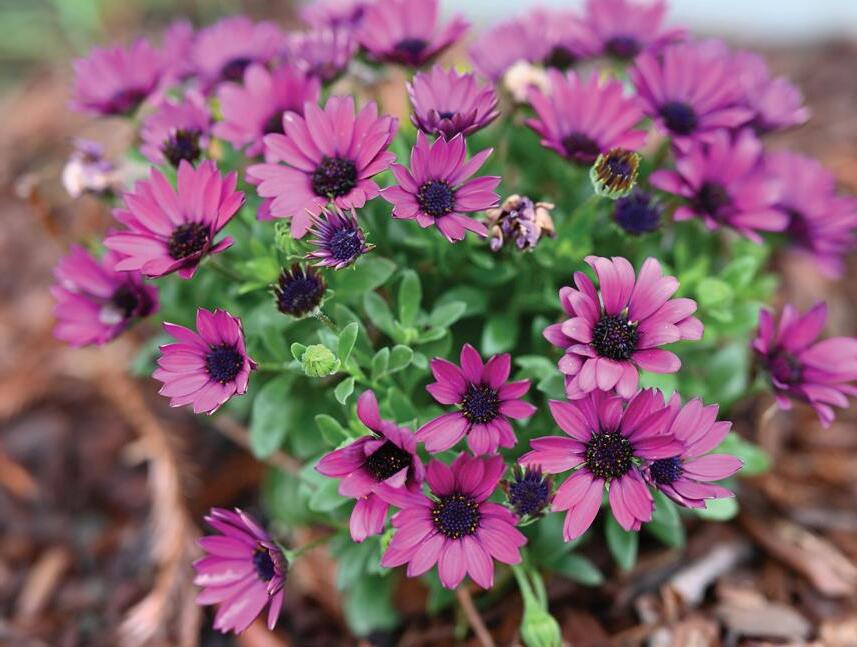
Cape Marguerite
Dimorphotheca ecklonis

Bunch-flowered daffodil Narcissus tazetta
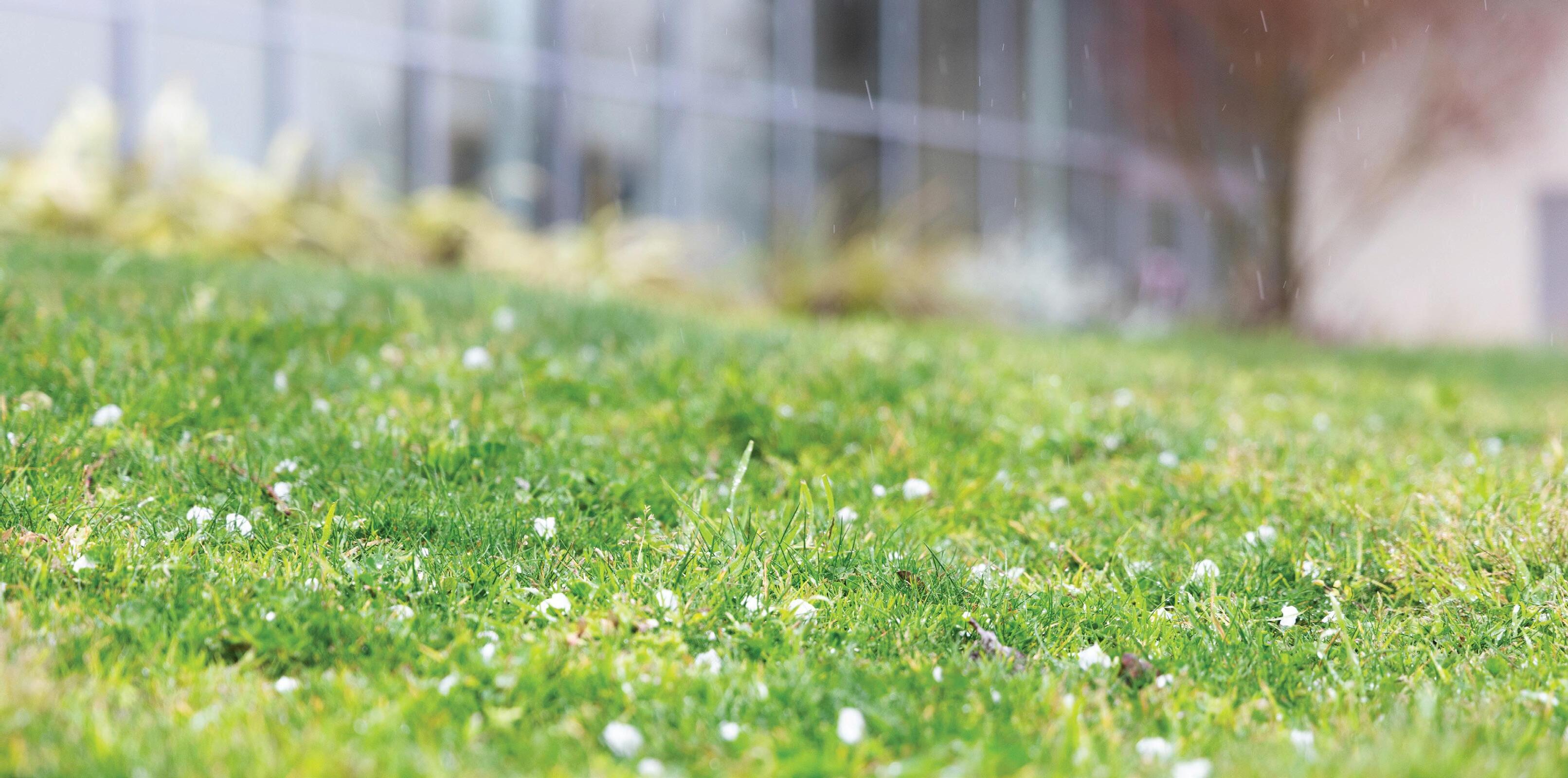
Sitting on the bench during the game, a basketball player locks eyes with his dad on the bleachers, his gaze fixed. The player’s shoulders tense as he waits to enter the match, knowing that each minute on the court will be scrutinized on the drive home.
“Every time I see my dad in the crowd, I feel a lot of pressure,” the anonymous basketball player said. “When I’m on the bench and don’t play much, that’s when he gets the most mad. As soon as I go on the court, I know I need to play well. When I don’t play well or don’t score a certain amount of points, my dad gets pretty mad at me.”
But things were not always this way. Originally, the player gained an interest in basketball through watching the dynamic playstyle and excitement of Stephen Curry and the Golden State Warriors. After watching his first NBA game, he fell in love with the sport, wanting to be like Curry. His dad completely supported his decision.
“From a young age, my dad put me in
a lot of leagues and with one-on-one coaches to try to get me better,” the basketball player said. “Outside of that, we would also go to the park and do drills together — at first, I didn’t really know how to guide myself, so it was helpful.”
Parent of two golf athletes Vincent Hu commented on how parents can make the first choice to balance their support for their children in athletics.
“It’s essential for kids to develop a genuine passion for what they do,” Hu said. “I try to keep it fun. If they don’t feel like practicing, that’s okay. Sometimes, after a tough tournament, they want to train harder, but I encourage them to relax. There’s no perfect solution, but forcing kids to practice when they’re not motivated is not productive.”
season, I just didn’t like playing, because every single time I would go out there, I would just be stressed.”
When parental involvement crosses from encouragement to overcontrolling, the athlete’s love for their sport often shifts to showing signs of dread. This pressure can intensify especially with the possibility of college recruiting, where some parents also pressure their children to perform better and reach the standards of Division I coaches.
“Nowadays, I know what to do,” the basketball player said. “I think they can relax a bit, but they just want to be involved a lot. Towards the end of the season, I just didn’t like playing, because every single time I would go out there, I would just be stressed.”
Sports can carry the connotation of highly competitive environments where teams or individual players ultimately triumph over another in a high-stakes match. However, for those that still want to play sports without the pressure, pickup games offer more relaxed and flexible options.

Athletes can strengthen their skills with this early parental support, but as they gain more experience about the sport and become more independent, they can begin to chafe from the constant presence of their parents.
“Nowadays, I know what to do,” the basketball player said. “I think they can relax a bit, but they just want to be involved a lot. Towards the end of the
When parental involvement crosses from encouragement to overcontrolling, the athlete’s love for their sport often shifts to showing signs of dread. This pressure can intensify especially with the possibility of college recruiting, where some parents also pressure their children to perform better and reach the standards of Division I colleges’ sports coaches.
“Even with every practice, it would be pretty stressful,” the basketball player said. “During the start of the season, I liked it, but over time, he really increased expectations on me, and it definitely hurt my enjoyment of the game.”
Pickup games allow athletes to play on informal teams in a casual environment without the constraints of a strict point system or league. Most pickup games operate on an open invitation basis, where players can join community groups or simply show up at local courts, fields and gyms during playing times.
Beach volleyball player Claire Sun, a senior at Castilleja, plays pickup beach volleyball after school and on weekends. Since most beach volleyball clubs are in Berkeley or Santa Cruz, making daily commutes is impractical. Instead, Claire plays pickup to continue honing her skills even outside of clubs.
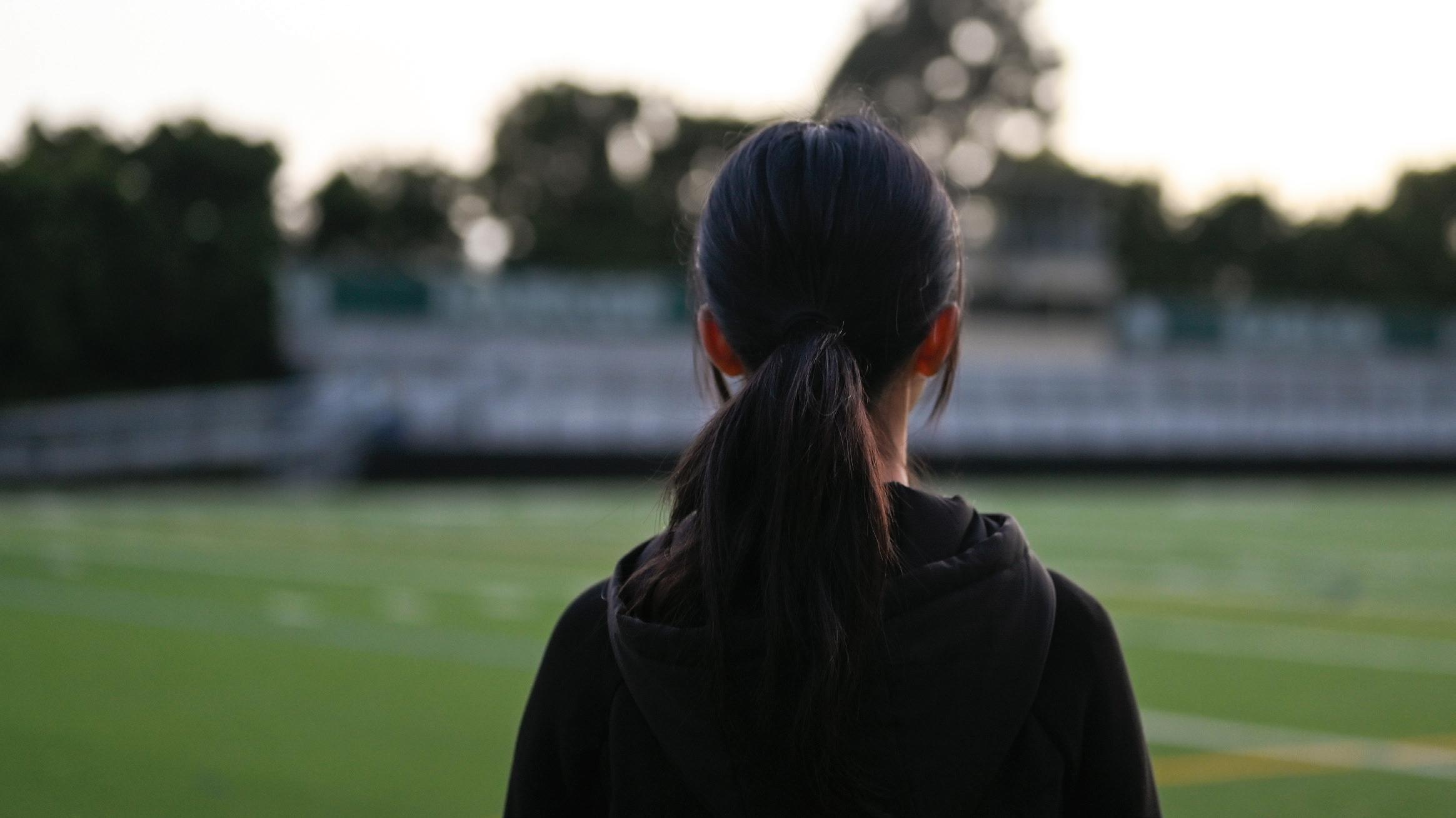
Visit harkeraquila.com for more.
“I’m part of adult pickup groups and essentially there’s these big group chats with 80 to 100 people in them,” Claire said. “Somebody will be like, ‘Anybody down for a game today?’ and people would just show up. It’s a great way to meet new people of all different skill levels. Everybody is there to have fun because they truly love the sport.”

As the clock ticks down, a young boy skates out onto the center of the ice rink to take the penalty shot. From the bench, his teammates chant his name as he squares off against the goalie. With an echoing boom, he sends the puck flying into the back of the net. When Charlie Conway scores the championshipwinning goal, the crowd erupts with joy—not just inside the stadium, but
also in living rooms across the world as viewers celebrate the Mighty Ducks’ fictional victories along with them.
“The Mighty Ducks,” released in 1992, serves as the quintessential underdog sports movie. With its unlikely team dynamic and miraculous turnaround, the story captures the excitement and emotional highs of the competition. But while the movie highlights the triumphs of sports, it also reflects the way films often simplify reality, distilling the complexities of real athletic experiences into profit-driven narratives.
Visual arts department chair Joshua Martinez noted why sports movies are such a popular genre of film.
“The reason a lot of us like to watch sporting events is because the hero’s journey is baked in,” Martinez said. “There’s a time clock and at some point someone’s gonna do something

spectacular, and that’s what’s gonna create the triumph and tragedy. The narrative of filmmaking and the narrative of sport is already aligned in a way that makes it easy to map one on to the other.”
Film club president Ethan Guan noted how the creative process of transforming a storyline into a movie can often distort reality. As producers aim to broaden their audiences and revenue, oftentimes, viewer engagement takes
“The narrative of filmmaking and sport are already aligned in a way that makes it easy to map one onto the other.”

JOSHUA MARTINEZ VISUAL ARTS DEPARTMENT CHAIR
precedence over accuracy.
“Film has to fit within two to three hours maximum, so even when a director tries really hard to stay true to the source material, they have to cut the parts of life that makes life feel mundane so film feels
Varsity boys basketball player Timmy Chen (11) frequents local gyms like OFJCC and Bay Club Santa Clara for pickup basketball games, where athletes gather to play short games to 15 points on two courts. Players rotate through teams in 2v2 or 3v3 formats.
“Pickup is that perfect intermediary where you don’t have to give it that much of a commitment, but you’re still able to play the game with other people,” Timmy said. “It’s way more laid back. You’re not really trying to be super good, you’re not super competitive — you’re just there to have fun.”
Junior varsity boys soccer player Luca Barchietto (10) regularly joins pickup soccer games at local high schools like Cupertino and Lynbrook. These gatherings are organized on an online group with about 300 members and typically attract 10-30 players of varying ages and skill levels every day.
“Pickup is less stressful environment than high school sports because people aren’t counting every goal,” Luca said. “If you make a mistake, no one really remembers. I’m free to try out whatever I want without fear, which drives me to try out some new things, which I normally would not try.”
Ttiffany zhu & lily peng
wo outs, up by one run at the bottom of the seventh inning. Sophomore Shaurya Jain steadies himself on the mound, ready to pitch as the opposing team’s batter steps up. With this pitch, he can secure his team the victory. Using calculated precision, he delivers a fastball. The batter swings, but the baseball whizzes by his bat and into the catcher’s glove. Just like that, a season of wins culminates in a final triumph.
Shaurya recalled his district championship win with the Cupertino Little League Juniors team two years ago.
“When we noticed we got that out, everyone rushed onto the field,” Shaurya said. “We were in disbelief because it was our first big win together. That season was a great season, and that win was just the best way to end it.”
Shaurya first started playing baseball at age seven, following in the footsteps of his brother and DIII baseball athlete Adi Jain (‘24). In the Cupertino Little League, Shaurya’s talent became evident as he improved rapidly. After just one season of T-ball, Shaurya moved up to the second level of a farm team and then a Minor League Baseball team within a year.
“
Every lineup is different and every team is different, so I always need to adapt to what they don’t expect.”
Now, he divides his time between Cupertino Little League in the summer and Living Legends travel ball in the fall, where he participates in showcases and development camps.
Because he is versatile across several positions, Shaurya steps up to lead and take on the empty positions when the team is short-staffed. He carries a special affinity to playing shortstop and pitching.
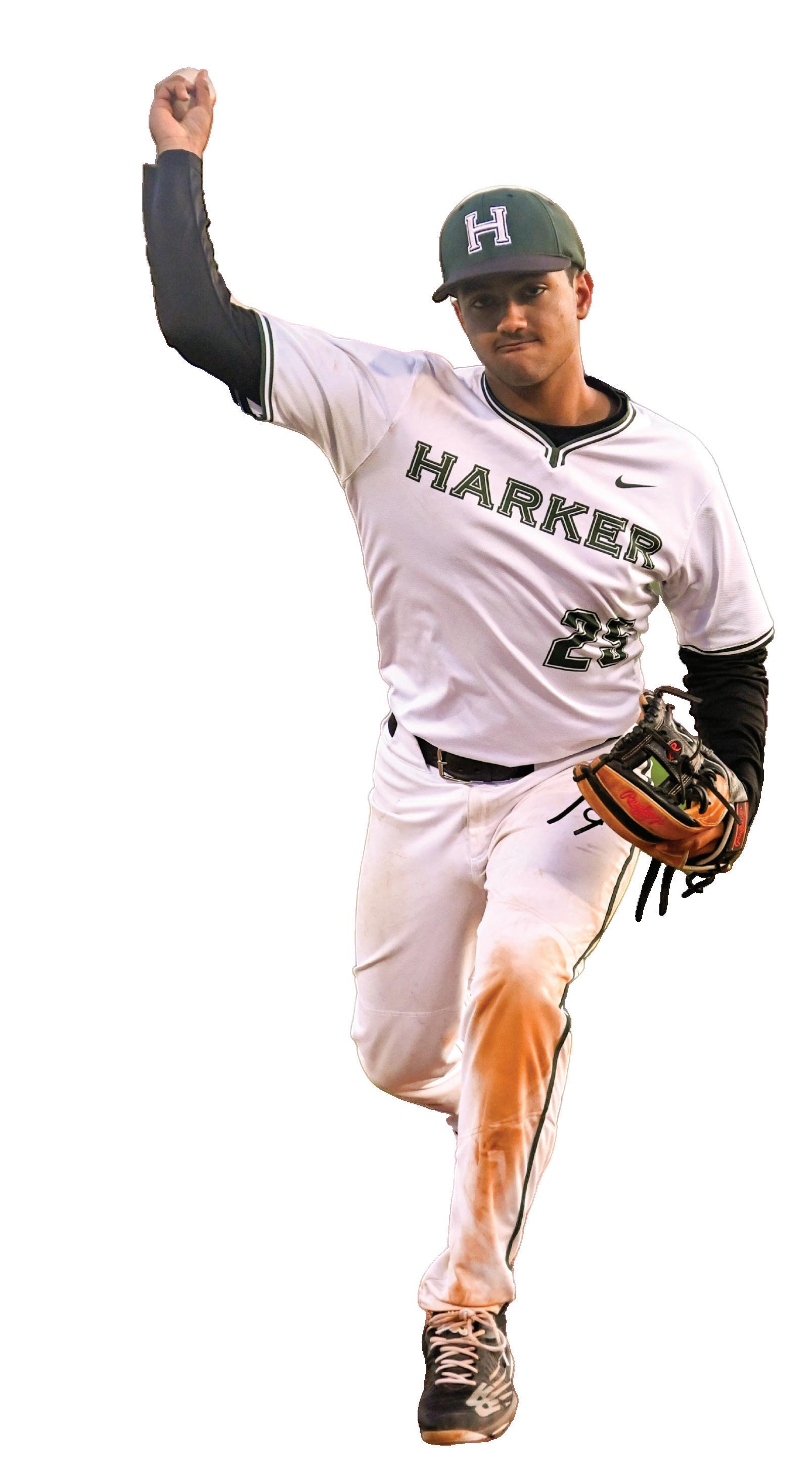
Endings are always bittersweet. I knew it was inevitable that the season would come to an end this year; yet I still find myself reaching out again. Four years on varsity with 15 hour weeks — that I definitely complained about — I’m not ready to let go.
I’ve played basketball almost every day since third grade and with some of
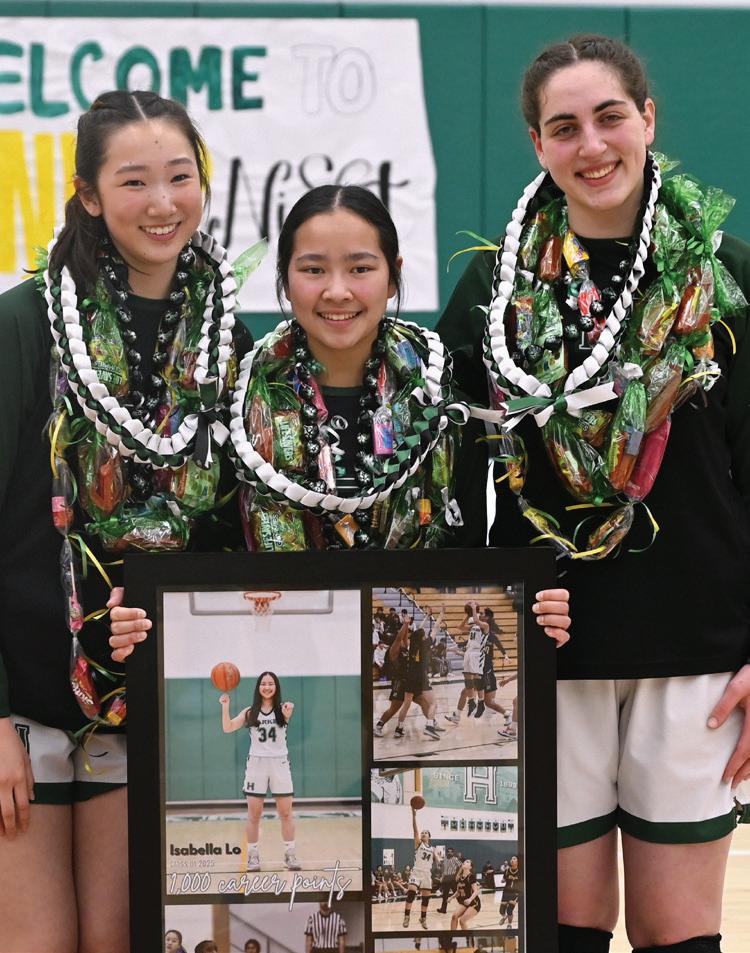
the same teammates since then. Even though I’ll be lucky enough to play in college, the end of high school basketball marks the end of the most meaningful experience of my life. I’ve learned how to push through struggles, how to navigate relationships — basketball has shaped the person I am today.
I’ve loved playing with a team, undergoing all the ups and downs of a long season together. Those shared secret smiles after running mountains or the heartbreak of losing in CCS are moments taken together.
Throughout the season, we build a trust and understanding that comes only from playing together. When I rotate over to help in defense, I trust my teammate will drop to cover my assignment. When I walk to the bench to grab my water bottle during practice, I expect a teammate to jokingly toss a ball at my head. It’s a different kind of joy to share the same mentality and goals with a group, to play for victory and each other.
I remember my nervousness and hesitancy as I stepped into a new environment as a frosh. Not just the increase in physicality of the high school game but a different team. Together, we celebrated the vibrant successes of that season of win streaks, playoff runs and the long bus rides in states. Sophomore year was a learning curve in tougher


gabe sachse & wenjie zou
The NCAA March Madness tournament and its 68 teams are back with their annual flurry of upsets, buzzerbeaters and championship dreams. Both the men’s and women’s tournaments promise high-intensity matchups, showcasing powerhouse programs like Duke and the University of Connecticut and rising stars set to take the spotlight. As the tournament tips off, students share their predictions on which players and teams will make the most noise on the footway to the Final Four.
“ I picked UCSD in the first round because I believe in the underdogs — though some schools were ranked lower, they were on the rise.”

“
competition, growing from the struggles. Junior year was a season of building confidence and momentum.
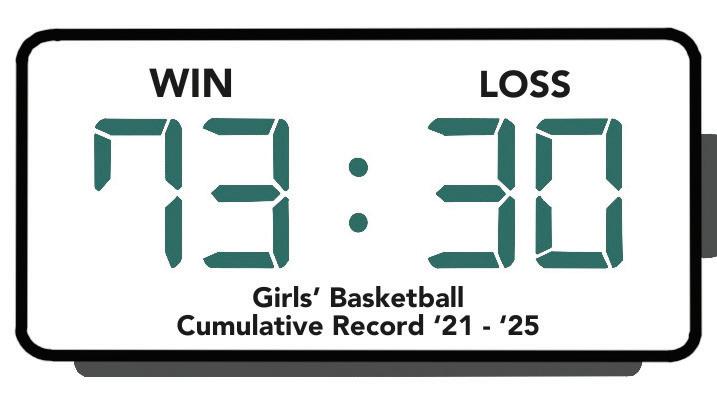
In the last win-or-go-home playoff game of senior year, I remember those last few seconds when I looked up at the score and saw the insurmountable 10 point deficit glaring back at me. I’m never one to give up and stop playing, but in those moments, I couldn’t help but calculate the probabilities, run through the scenarios and recognize the impossibility of a comeback.
It doesn’t feel real that it’s over even now. I’m ready to head off to practice after school, to go grab bagels for the team. Basketball has dominated my life for so long that I wonder at times what else defines me or what else I might be capable of.
I’m still figuring out the answers to these questions. Something that’s part of your life for so long doesn’t go away without leaving holes and doubts.
NORAH MEHANNA (12)
BASKETBALL FAN
UConn can make a run again this year with Paige Bueckers still doing great. JuJu Watkins with USC has definitely also been on the come up.”

YASH
SACHEDEVA (11)
BASKETBALL FAN
“
I’m predicting Duke and Auburn will win on their sides. Yale beat Auburn last year, but that probably won’t happen again.”

ALEJANDRO CHELINE (11)
BASKETBALL FAN
“ In my bracket, I always pick a few upsets. They aren’t common, but they’re critical in a single elimination tournament.”

VIDWAT SHEKAR (9)
BASKETBALL FAN
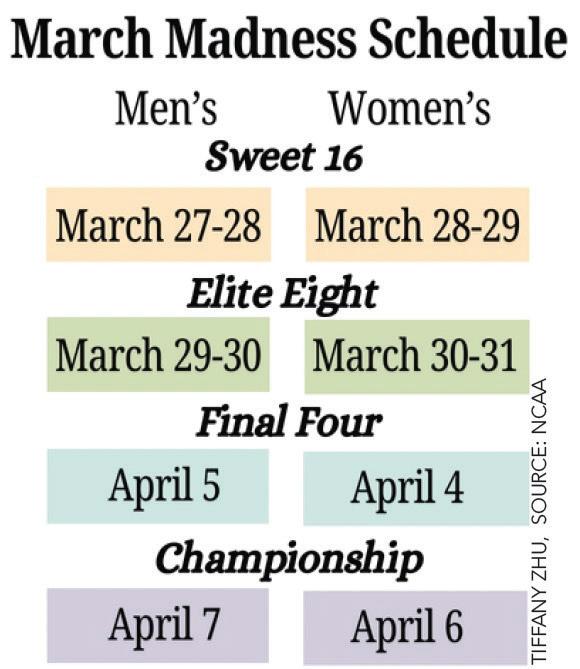

With over 11 Harker track and field events, the varsity team gives athletes the freedom to explore different events and discover their strengths. Track and field is divided into three categories: running, jumping and throwing. At Harker, athletes compete in events like sprints, relays, long jump and discus.
Practicing daily at Prospect High School, team members of all levels can challenge themselves and try new events under the guidance of coaches. Often, athletes can discover unexpected talents along the way.
While most events are individual, relays provide a chance to compete as a team, building teamwork and developing friendships. And for those who aren’t drawn to running, throwing events offer alternative options.
The track and field team competes next at the Lynbrook Invitational on March 29.

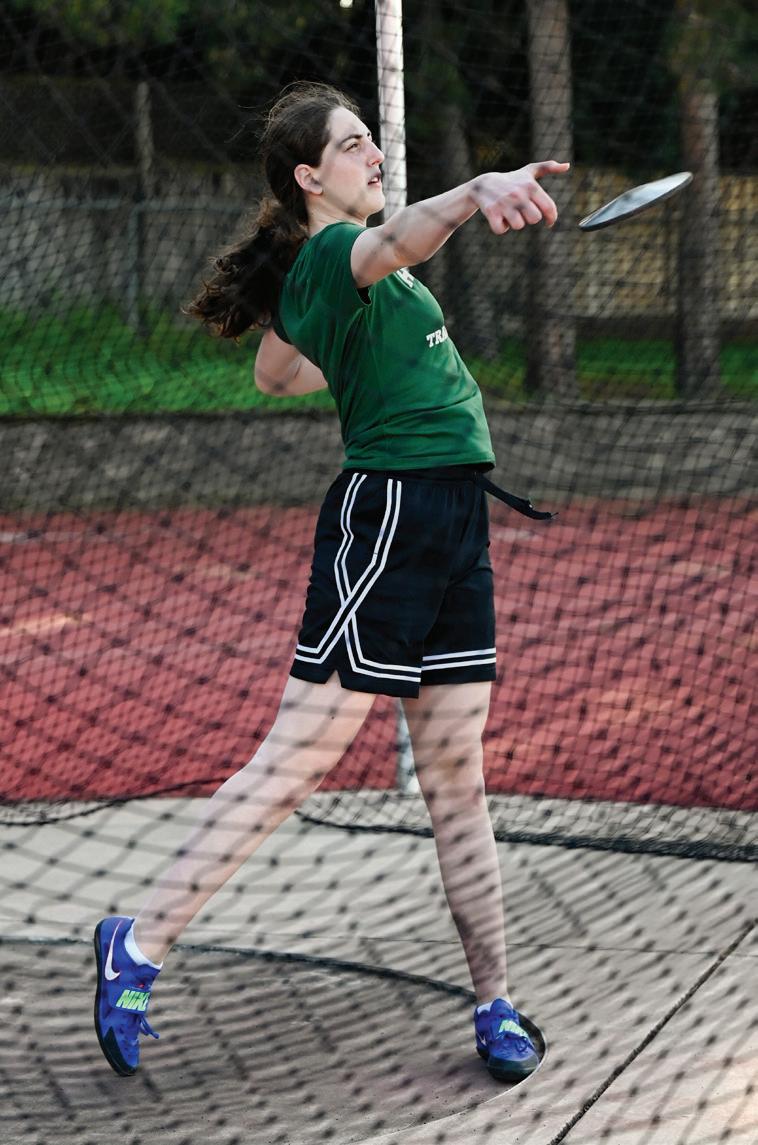
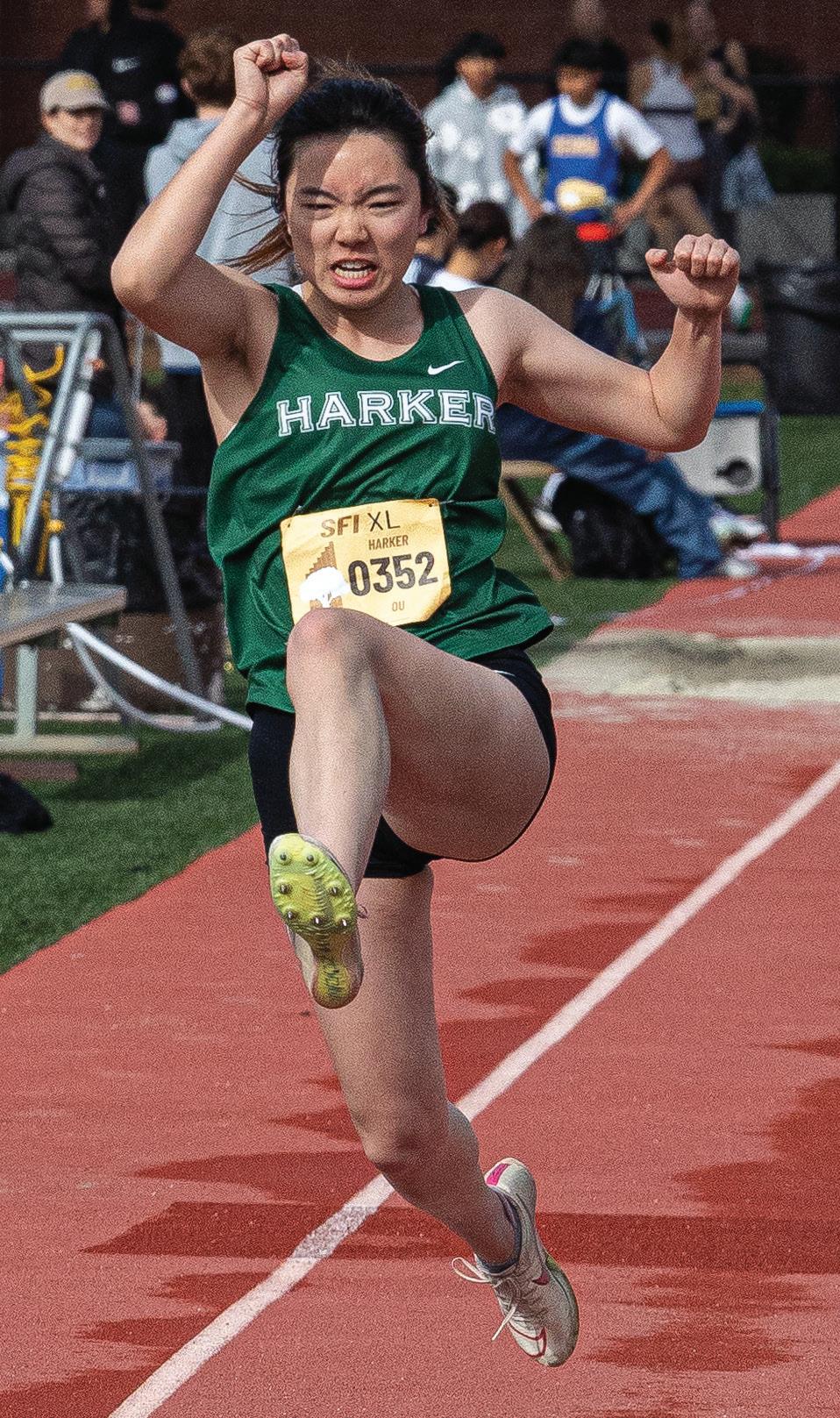
“Because track and field is an individual sport, each of us can really focus and specialize in different events. I like doing long jump because it’s exciting.”

SOPHIA OU (11) VARSITY TRACK AND FIELD
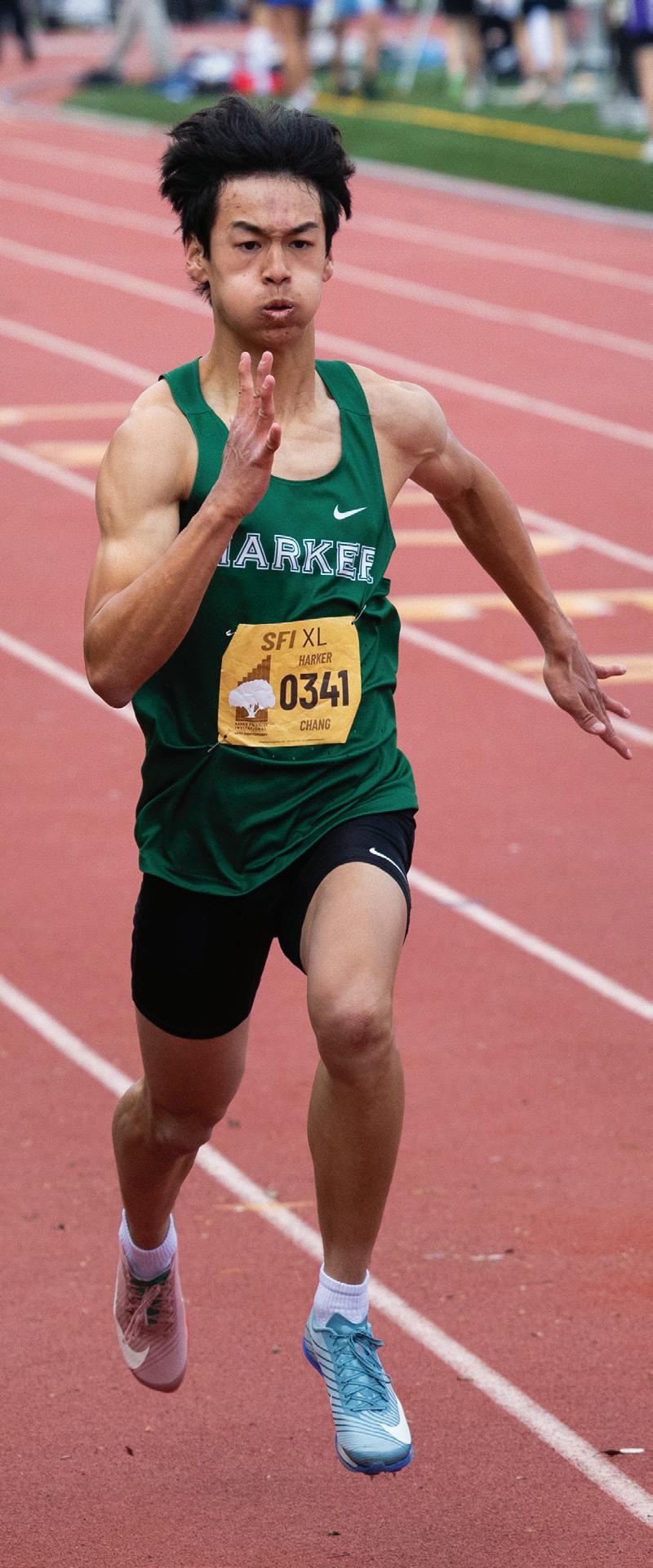
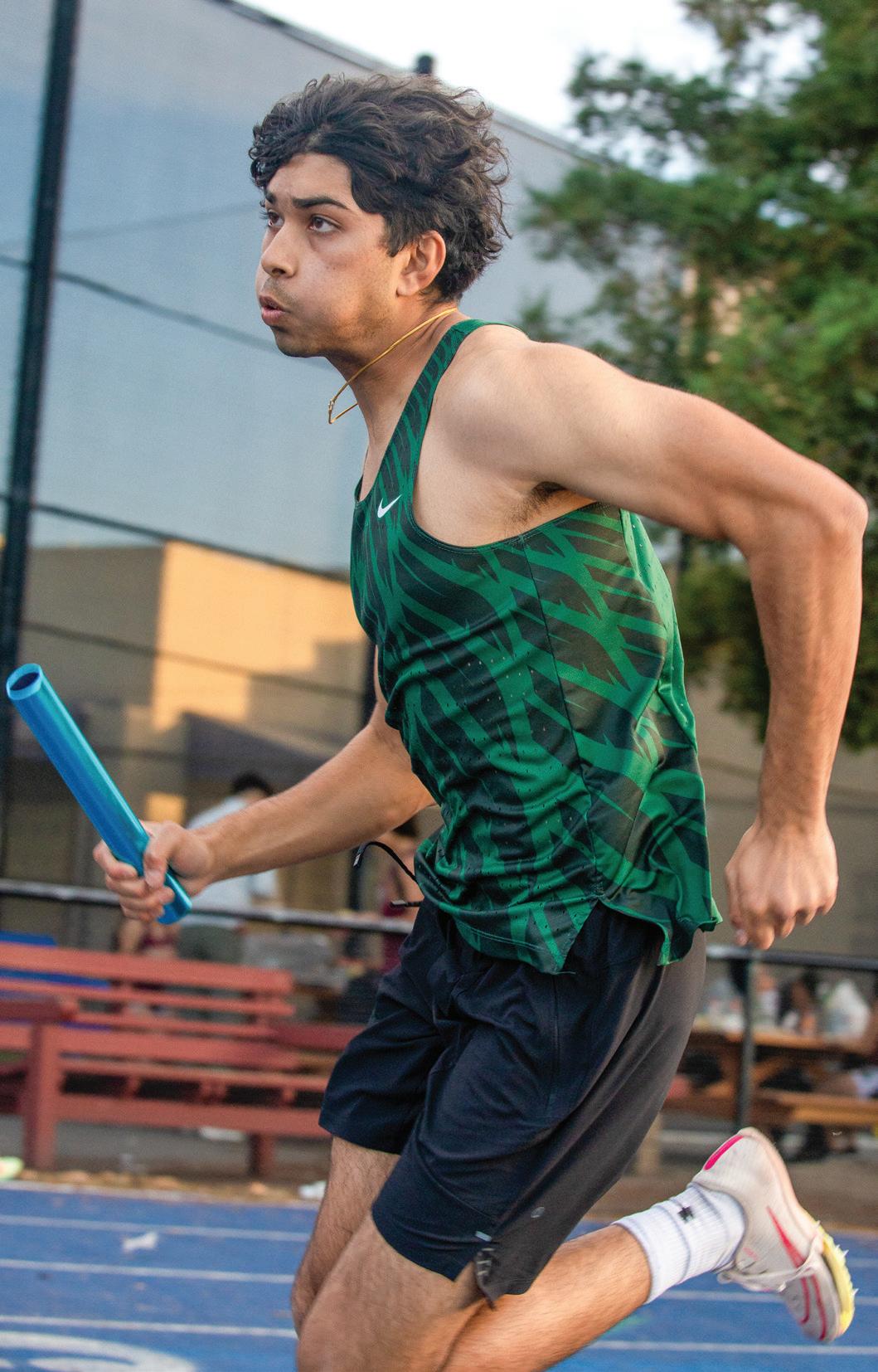




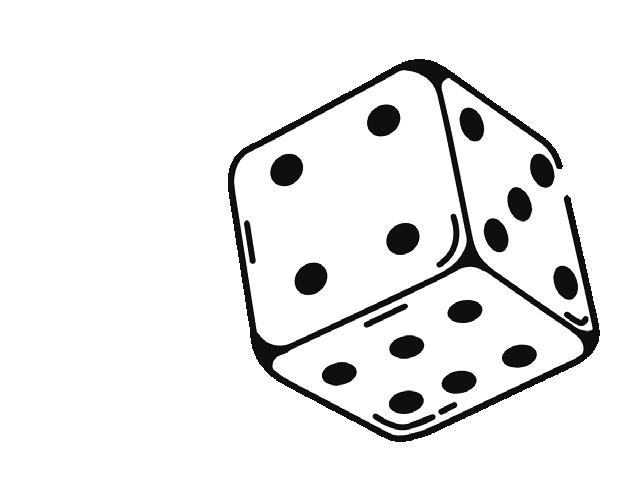



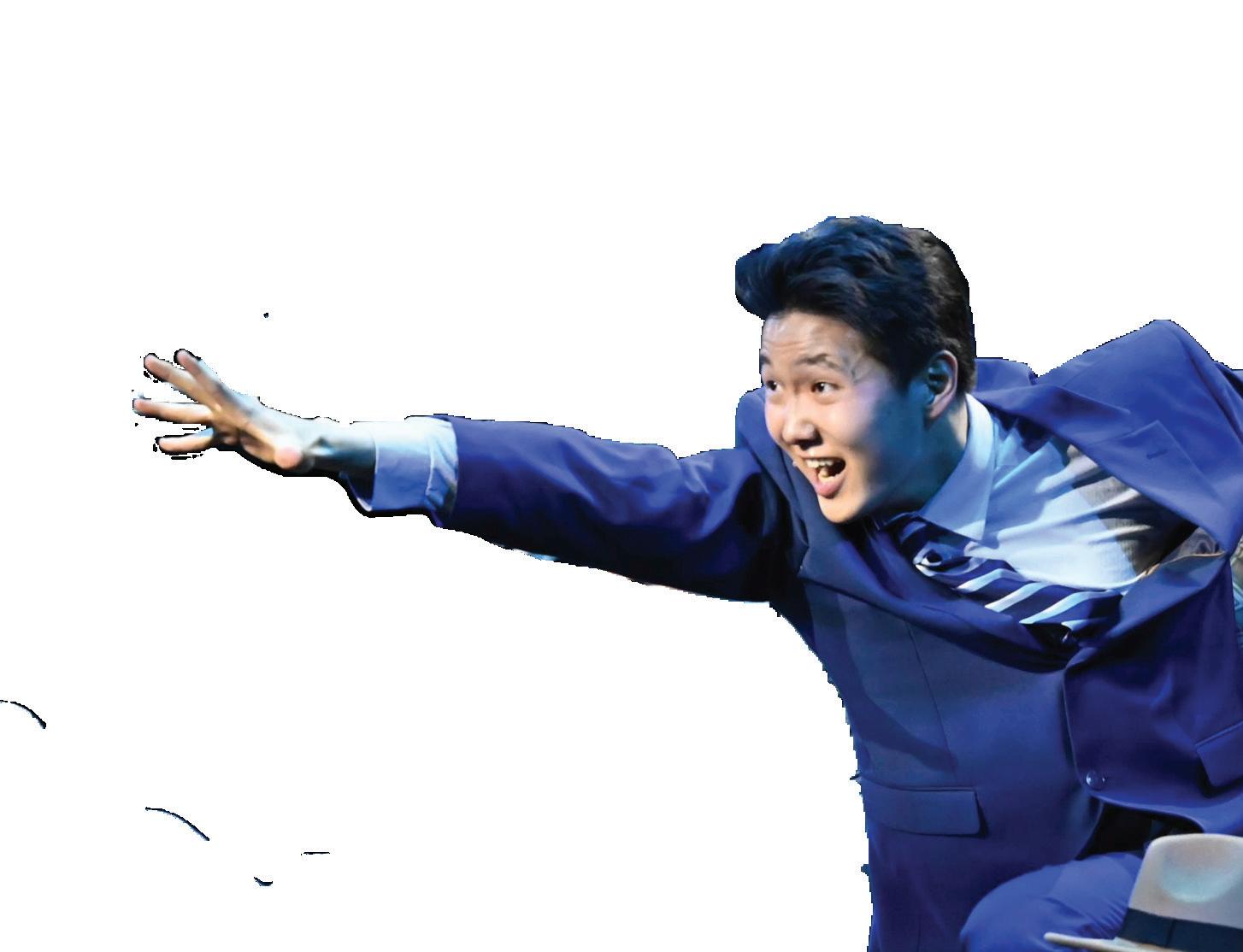
Nabout their daily lives in the city.
Impatient drivers honk their horns at newsboys in the street trying to sell newspapers to them. Pedestrians bump into each other, speeding past each other on the sidewalk. This captivating tableau set the stage for the musical “Guys and Dolls,” performed by cast and crew and directed by Laura Lang-Ree from March 20 to March 22 in the Patil theater. The show was last performed at the middle school in 2017.
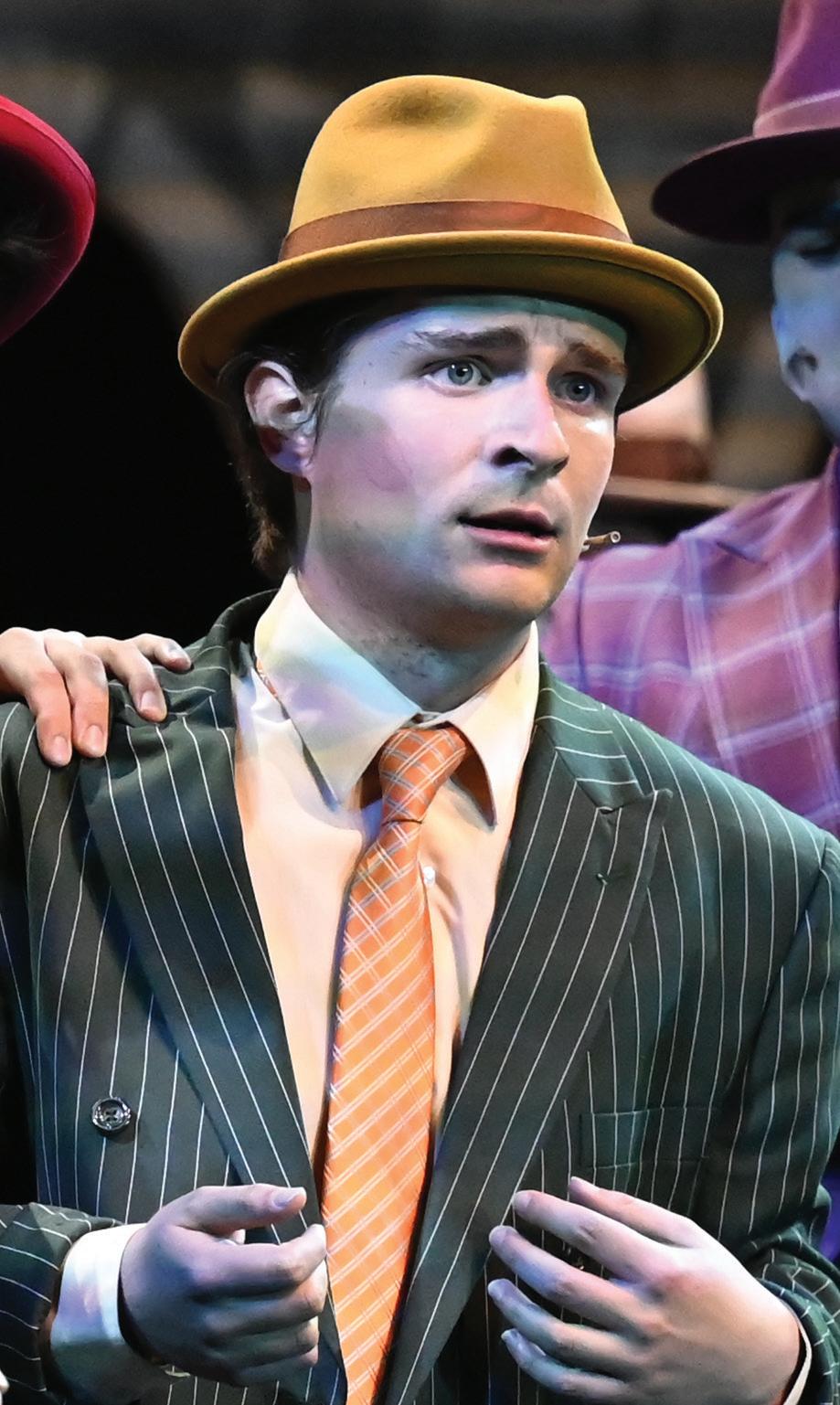
Played by senior Leo Sobczyn, Nathan Detroit runs an illegal floating craps game, where players bet on the outcomes of a roll of dice. Nathan is constantly looking for new locations to host his game while avoiding the authorities. Despite the risks, he remains confident in his ability to keep the operation running smoothly.

in the lively streets of 1950’s New York, following the story of a group of gamblers and their many activities.
Senior Leo Sobczyn plays Nathan Detroit, a businessman who organizes an illicit dice-rolling game. He holds a rivalry with gambler Sky Masterson, played by senior Jason Shim. Nathan bets that Sky will not go on a date with Sergeant Sarah Brown, a pious missionary played by senior Ananya Das. Alongside his bet with Sky, Nathan faces his own relationship issues: his fiancée Adelaide, played by
senior Bhavya Srinivasan, is discontent after fourteen years of engagement. The story unfolds with these four characters at its heart.

“I’m so grateful to have been given the opportunity to play Sky in my final year at the Harker Conservatory,” Jason said. “Besides the obvious allure of gambling and sliding down sewers, this role gave me a chance to showcase the emotional and vocal maturity I’ve been working towards over 4 years. Thanks to Guys and Dolls, I’ve made some memories and friendships that will last me a lifetime.”
MESSY MINK Miss Adelaide, Bhavya Srinivasan (12), shows fierce attitude during “Take Back Your Mink.” SNAKE EYES Jason Shim executes the final flourish of his solo number, “Luck Be a Lady,” when he gambles his future with Sarah against his gambler friends’ souls.
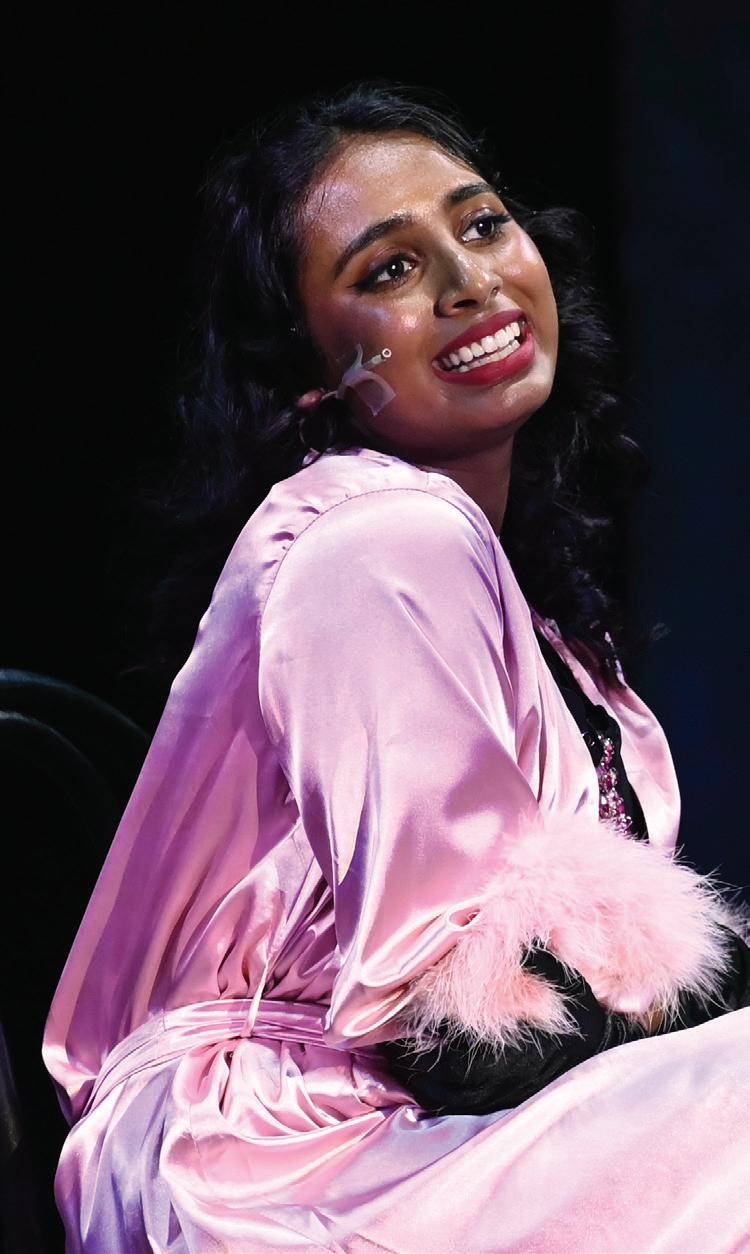
The lead performer at the Hot Box nightclub, Adelaide has been engaged to Nathan Detroit for 14 years. She dreams of starting a family but grows increasingly frustrated with Nathan’s inability to commit. Her character balances humor and vulnerability as she navigates the stress that comes with Nathan’s business.

Portrayed by senior Anaya Das, Sarah Brown is a dedicated missionary at the Save-a-Soul mission, who strives to reform the sinners in New York city. Even with her passionate convictions, she finds herself drawn to the notorius gambler Sky Masterson. She discovers a new side of herself through their relationship.
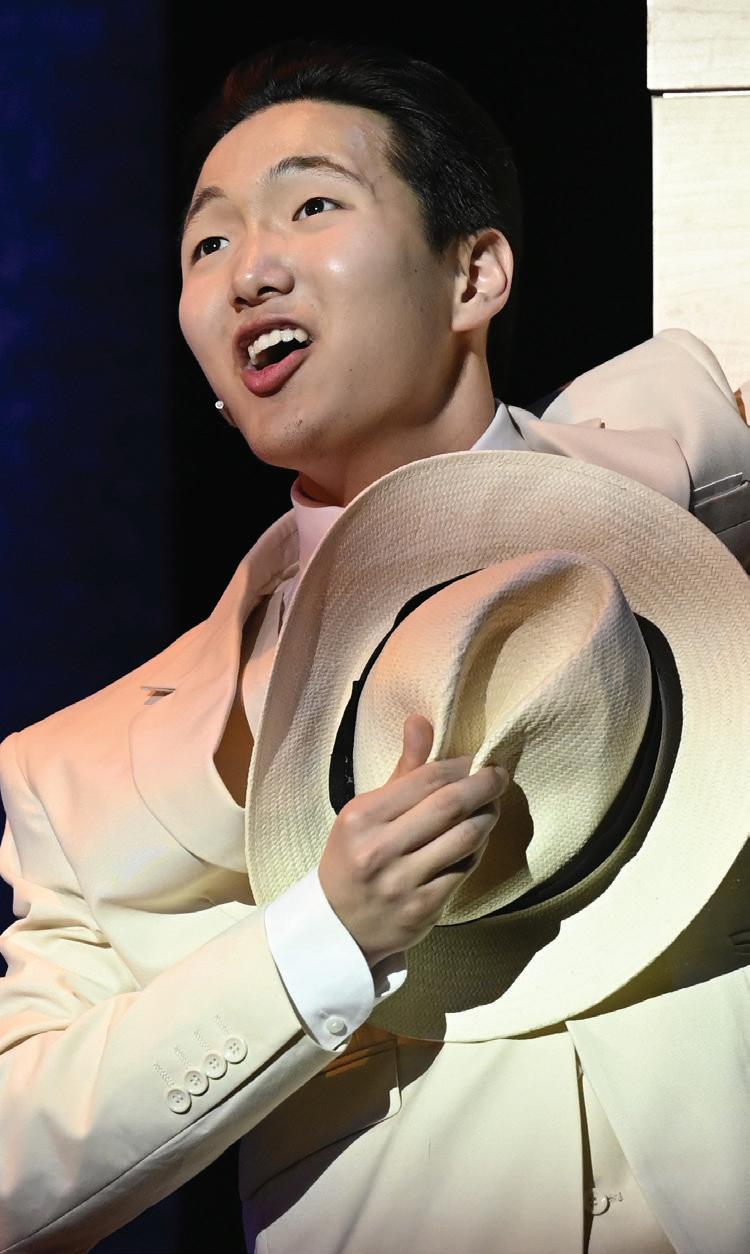
Senior Jason Shim presents Sky Masterson as a charismatic and smooth-talking gambler. When challenged by Nathan Detroit to woo the virtuous Sarah Brown, he initially sees her as just another bet. As he spends more time with her, Sky finds himself genuinely falling in love and reconsidering his carefree lifestyle.